- Subscribe/Renew

- Athletic Administration
- Concussions
- Sports Medicine
- Strength & Conditioning
- Athletic Leader
- Glossary of Terms
- Track & Field
- TechTime Videos
- 2024 Coach & A.D. Buyers’ Guide
- 2024 Winning Football Playbook
- 2024 Winning Hoops Coaches Playbook
- 2024 Coach & A.D. Tech Guide
- 2023 Digital A.D. Toolkit
- *NEW* TechTime Videos
- Educational Webinars
- Exclusive Downloads
- Podcast Archive

Defending The Trips Formation
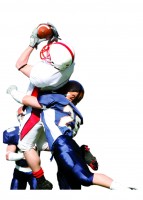
The top-tier teams in our conference all run versions of the spread offense. We utilize the 33 Stack defense and our coaching staff works hard on adjusting blitz concepts so as not to compromise our secondary coverages. Our “Buster” scheme, as we dubbed it, has been an integral part in defending against our spread opponents.
The Master Of Disguise One of the more popular spread-formation looks our opponents use is the Trips or 3-by-1 set. By having three receivers on one side — a wide receiver (WR) and two slot receivers, or, a WR off the line of scrimmage (LOS) with a slot receiver and a tight end — and a WR on the weak side, the offense creates an unbalanced-spread look, which challenges the defense to match up. When this occurs, the defense must account for three receivers on the strong side and the backside receiver, plus stopping the run.
The offense’s goal is to create misdirections to befuddle the defense. So, to counter this, your defense needs to disguise what it wants to accomplish — disguise a blitz or disguise the coverage.
The use of disguise in our Buster series is the solution to getting maximum coverage on the strong side, while preventing weak-side vulnerability — all the while serving a heavy dose of the blitz. Buster creates confusion and misreads by the QB. This leads to sacks, interceptions, fumbles, incompletions or stuffing runs.
Beating The Offense With ‘Buster’
Buster is an audible call out of our regular defense. The Buster audible series may appear complicated at first. When coaches break it down, however, it is easily taught. Our players have come to enjoy the problems Buster creates for opposing offenses. And, the “big play” opportunities for every defender on the field play an important role in the players learning their assignments.
One method we use is to “flop” our ends, spurs and outside linebackers (LB) in our 33 Stack defense. Aligned to the strong side are the defensive end (E in the diagrams), Sam Linebacker (SLB), and the Archer LB (a spur). Aligned on the weak side are the speed-end rusher (R), Will LB (WLB) and Lance (another spur).
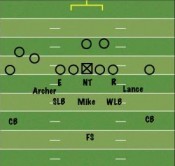
These movements now create a Cover 2 shell look for the QB’s read as he is in cadence.
The Archer stems, aligning with the No. 3 (inside slot) receiver. The Archer’s outside leg splits the No. 3 WR’s body.
The timing of the movement from what Diagram 1 shows to the look of Diagram 2 is determined by your coaches during game planning. From watching the opponent, here is a good rule of thumb: the moving defenders should watch the center.
Centers tend to look through their legs to get an accurate reference point of snapping the ball to the QB. Centers look up prior to snapping the ball. Between the initial QB cadence and the snap, the QB is seeing the defense shift into a Cover 2.
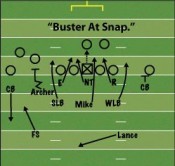
Defending Adjustments After you stuff the basic trips formation a few times, the offense typically smartens up and adds some adjustments to its look.
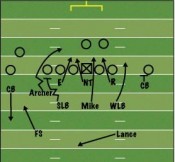
The speed option to the weak side is a popular running play for spread offenses and it is addressed within the Buster audible.
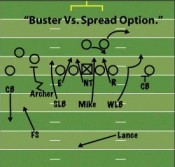
If the defense makes the “strength” call when the offense lines up in a 2-by-2 set, and when the offense motions to trips, the potential for confusion exists. To follow suit and audible to Buster would mean a wholesale shift of personnel from one side of the field to the other. To avoid such confusion, go with Buster Opp (see below).

At the snap, E takes an initial step toward to offensive tackle. He then backs off into flat coverage. The Archer LB has taken his outside pass rush with the SLB blitzing the B-gap. The defense is still rushing six, and it becomes a “cat-and-mouse” game with the QB — that’s why the zone blitz is named Minnie.
The “Cincy” audible (see below) out of Buster is a weak-side CB blitz and is a second option for your defense against the offense motioning out of Trips and into a 2-by-2 formation.

While the CB stems, the SLB and Mike LB stem to a 30 look; lining up 3 1/2 yards from the guards. The FS stems to a 1-by-7 look on the strong side. On the snap, the nose tackle (NT) stunts to the weak-side B-gap. The SLB and Mike LB blitz the A-gaps.
A delay blitz by the Mike LB may work best, depending on the direction the center takes. The WLB takes the flat coverage to look for the ‘hot’ route. The Lance covers the weak-side receiver deep, with the FS jumping the “hot” route by the strong-side slot or wide out.
For the empty formation (3-by-2 look with only the QB in the backfield), make a minor tweak.
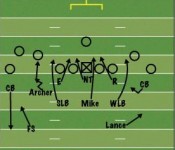
You Might Also Like
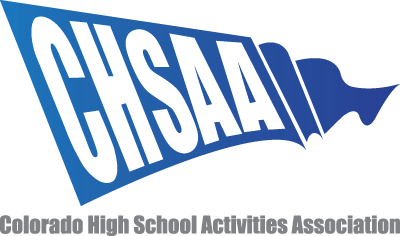
One thought on “Defending The Trips Formation”
Here is a link which provides video of Buster. https://www.youtube.com/watch?v=gsmh6gRCbKQ
Leave a Reply Cancel reply
You must be logged in to post a comment.
Latest News
Hiring an athletic trainer to your department, former toledo assistant coach sues school for $10m.
More News »
Popular Now
- 10 must-read books for coaches & athletic directors December 21, 2023
- OSAA defends gender policy regarding trans student-athletes April 23, 2024
- Hiring an athletic trainer to your department May 22, 2024
- Study: Parents’ sideline behavior greatly… April 16, 2024
- Former Toledo assistant coach sues school for $10M May 22, 2024

A.D.ministration: The importance of supervision
coachad.com
Share on Facebook Share on Twitter Share on Linked In Share by Email
[email protected]
(616) 520-2137
- Update Your Subscription Address
- Editorial Submissions
- Privacy Policy
- Cookie Policy
- Terms of Use
- Do not sell or share my personal information

Subscribe Now!
- Cross country
- Sports 40 Under 40 Awards

Must Have Trips Passing Concepts in the Spread Offense
Trips is a great formation to get into because it can lead to advantages in the box for the run game and it can clearly define the space that needs to be attacked in the pass game. I personally like trips formation because we tag our quick pass game to our run game on almost every single play, and because of trips we are able to put the ball where we have a numbers advantage.
When we face 2-hi defenses against our trips, I usually aim to attack the flat space in our quick pass game with bubbles, quicks, stick routes etc. because our 3 receivers have 2 immediate threats on defense (CB & OLB). Clearly, these numbers favor us on offense and is space that needs to be exploited.
In this article, I’m going to share a few trips passing concepts that will cause serious confusion for the defense and give you the advantage you need to win through the air.
Trips Passing Concepts
Smash drive concept.
Smash + Drive is a trips passing concept that is a personal favorite because it has answers for multiple coverages.
Typically, the trips are to the field and to the boundary will be a single WR in a nasty split, or an attached TE. The smash concept will be ran to the single WR side. The single receiver will run the corner and the running back will be on an arrow route into the flat. The smash to the boundary can hit successfully against teams that put the nickel to the trips and play cover 2 or 1 to the boundary.
The drive concept comes from the field with the #3 WR running a deep dig at 10 or 12 yards and a shallow cross from the #2 WR.
#1 WR can run a variety of different routes but some of the most common routes are a slant behind the dig or a 5 yard in route.

Here’s a clip of Tulane running the drive smash concept
The QB’s eyes immediately go to the boundary. The CB is pressed to the outside on the #1 WR running the corner (pre-snap read should eliminate the corner route based on leverage), so QB is anticipating the arrow out of the backfield.
With the LB expanding and covering the back into the flat, the QB then progresses to the middle of the field on the drive. The shallow cross comes across nicely under the LB that is getting depth in his drop and the ball is out for a nice completion and gain.
Here’s another example of the concept from Penn State running it with an attached TE
This is a simple read for a QB as the smash concept puts a nice hi/low on the CB to the boundary. Pre-snap read indicates that both routes are available as the nickel is to the field with a 2 high safety look.
The safety is inside on the attached TE which leaves uncapped, or open space for the corner on the break point. This is where the hi/low comes in as the QB will get his eyes on the CB and essentially throw it to where he’s not, or into the open space.
The CB immediately pedals into his zone and stays over the top and outside of the corner, so the QB plants on his 3rd step and throws the ball to the RB into the flat. A simple throw and catch leads to a 6 yard gain for Penn State.
Follow Concept
The follow concept out of trips is usually when one receiver is running a shallow which is “followed” by another receiver running some sort of an angle route behind it.
This concept is a good zone beater and man beater, especially against man defenses that want to “banjo” or switch responsibilities when receivers cross each other off the LOS.
Below is a diagram of how Jackson State ran their follow concept in 2022.

Here’s a clip of Jackson State running this trips passing concept.
In the concept from Jackson State, they use the #3 WR to run vertical at the OLB to threaten him vertically causing him to get depth at the snap of the ball. This movement is intended to occupy him for a split second for the 2nd shallow or angle route coming from the #1 receiver to slice in front of his face.
The #2 WR is running the first shallow cross in the concept and his job is to occupy the ILB by sitting down in the zone forcing the LB to attach to the route. This will occupy the ILB so he cannot expand and threaten the #1 WR who is following the route.
The #1 WR has to let the concept develop off the LOS for a split second with the vertical release by 3, and the shallow cross by 2. This is why he foot fires off the line of scrimmage before breaking in on his route.
The QB’s pre-snap read indicates zone coverage, and he’s anticipating throwing the follow route immediately out of the break. The QB knows the first crosser will occupy the ILB and the vertical will push the OLB just enough for the #1 WR to break underneath it. With great timing on the throw, #1 WR catches the ball immediately out of his break and is able to make a move for a 7 yard gain.
In the next diagram the follow concept comes from North Carolina who runs it differently than Jackson State, but accomplishes the same goal.

I like this follow concept because it’s ran out of a compressed bunch set with cross action off the line of scrimmage from all three receivers.
The movement off the line of scrimmage from the bunch set creates confusion as the defense finds itself out of alignment and exposed for a big gain.
Here’s the clip of North Carolina running the follow concept from a compressed bunch look.
The #2 on the LOS does a great job clearing out the OLB with his wheel route. The outside release on the wheel causes the OLB to widen and get depth.
The #1 immediately crosses underneath the wheel route with the ILB in his sight. His job is the same as before which is to occupy the first inside backer. In this example, the ILB not only attaches to him, but abandons his zone responsibilities and runs with him across the field.
The #3 WR allows the wheel and cross to develop by getting width at the snap of the ball. As the OLB maintains outside leverage because of the release on the wheel, the angle route cuts inside with a massive window for the QB to throw into.
Ultimately the QB is progressing through two routes, the first cross and then the follow. QB’s eyes immediately go to the first cross and he sees the LB attach. He then progresses to the angle follow and it’s a simple throw and catch from there for a huge gain. The QB does have a pre-snap alert to throw the Go route with the single WR, but the CB and Safety help to the boundary would make for a tough throw.
It’s important to note that the key to making this play happen is the wheel route by the point man in the bunch look. This player has to understand that his route is ultimately dead from the beginning and he’s sacrificing himself in order to move the OLB just enough for the angle route to open up inside. It doesn’t count as a catch in the box score but this is just as important and his teammates should be giving him props for setting them up for success.
Post Wheel can be ran a few different ways out of trips, but the way Western Kentucky ran their post wheel concept in 2021 really caught my attention. Below is a diagram of how WKU ran post wheel out of their trips formation.

What I like about the way WKU ran their post-wheel is how they used their strength in their screen game to set up the wheel route. In this trips formation set, WKU runs Post from the outside, flashes tunnel screen from the #2 WR with the #3 WR stalking the OLB before releasing on the wheel route.
Here’s the clip of WKU running post wheel
The defense has a man advantage over the trips as they walk LB out to get 4 defenders over the 3 WR’s with Safety help over the top. It appears the the defense might be playing 2-man which leaves a huge mismatch on the #3 WR and the LB.
The outside WR runs his post and the CB absorbs the post route.
The #2 and #3 make it look like they are running one of their successful tunnel screens. #2 flashes out on bubble before replacing #3 down the LOS. This triggers the OLB to get down hill and into the flat to break up what he thinks is a screen pass.
The QB does a great job recognizing the CB running with the post and gets a firm ball out on a wheel.
If you’re familiar Air Raid pass concepts then you may have heard of the China concept out of trips. The #3 will run a corner while #2 and #1 both run 5 yard in routes. It’s a great concept against multiple coverages whether it’s zone or man. Typically this concept is to attack space behind the CB with the corner route, or underneath with horizontal conflict on the OLB with the two 5 yard in routes.
Ohio State’s version of the China concept is using the #2 WR on a double move. He hits the top of his break point at 5 yards like he normally would on his in route, but now he stutters and attacks the open grass in the middle of the field.
Here’s how it’s drawn up:

The QB should be licking his chops before the ball is snapped as he sees the Free Safety outside shade of the #3 WR. This should indicate that he has the green light on the stutter go. The play action holds down the only linebacker in the box long enough and the QB throws a good ball over the middle with pressure in his face.
Here’s a clip of WKU running the China Go concept:
In this look, the defense put numbers to the field with 4 defenders over the 3 WR’s. Looking at this defense It appears they are playing stress coverage / 3 match as the Mike and Free Safety are taking all of #3 vertical. As the #3 runs his corner route, it clears open the middle of the field for the #2 WR to attack open grass.
This is a great concept for defenses that play MOFO without any help from the backside safety.
Double Corner Switch
When I first saw Ohio State run this concept in 2019, I had to watch it at least a dozen times. Every time I played the clip back I just kept thinking how impossible it is for a defense to cover it correctly.
Below is how Ohio State ran their Double Corner Switch concept

The defense is also adding numbers to the trips formation with 4 defenders over the top of 3 WR’s. The QB has a MOFO look pre-snap with plenty of open grass for the taking on the switch vertical by the #1 WR in the trips formation.
Here’s a clip of Ohio State running Double Corner Switch
The Corner route by the #3 WR is a high angle corner whereas the #2 WR runs more of a low angle, or flat corner route.
Regardless of what coverage the defense is in, and how they move their safeties post-snap, the look of MOFO is still the same. The LB’s in the box have no chance of carrying this vertical coming from the wide side of the field by the #1 WR.
The QB initially gets his eyes to the left side of the field and quickly works back to the wide side of the field as he sees the boundary safety roll down after the ball is snapped.
The vertical is able to get on top of the LB’s with his man chasing him in a trail technique. It’s a great ball by the QB, but more importantly great patience to let the WR clear the inside linebackers and get vertical before throwing a strike for a touchdown.
Benefits of Trips Passing Concepts
You can clearly see how operating out of trips can be beneficial to an offense. It opens up a number of options in the run game or pass game. This article touched on just on a few drop back passes, but there are several quick game concepts and screens that can be highly effective out of trips formation.
The other added benefit to operating out of trips formation is how your WR’s will align in the set. Whether it’s bunch, stack, or compressed you can really manipulate a defense and the space you want to attack based on your alignment.
Ultimately, trips formation and trips passing concepts are extremely difficult to defend. Every offense should develop their package of trips passing concepts for a more successful pass game.

- Trips Formation Football (4 Best Plays Out of Trips)
By Coach Martin | Football Offense
- You are here:
- Football Offense
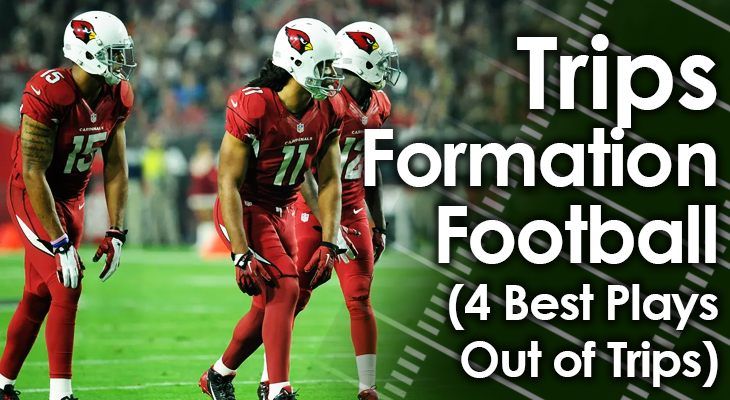
The Trips formation is one of the most popular formations in football.
A lot of teams use it in the modern game because it allows offenses to both spread the field and create confusion + chaos.
Below I'll explain what trips formation is, why it's so popular, and then we'll break down 4 of the best plays to run out of Trips formation.
Free Download:
"The Ultimate Guide to Football Defense" Booklet (254 pages)
What is Trips Formation?
Trips Formation has 3 wide receivers stacked on the same side of the field.
This can cause a lot of confusion for the opposition team.
Offenses can run it out of the shotgun formation or with the quarterback under center -- though most teams prefer to run it out of shotgun today.
In addition, most offenses will also have another wide receiver lined up to the opposite side of the formation all by himself. Doing so forces the defense to put at least one cornerback to that side of the field.
Why Trips Formation Works
Trips Formation is great at creating mismatches.
First, it forces the defense to either go with the Nickel formation , with five defensive backs on the field; or have a linebacker cover a receiver.
Next, it forces the defense to either:
1. Put four of those players to the side of the field with Trips -- which leaves the other receiver one-on-one.
2. Or put a safety over top of the lone receiver -- which puts all three receivers on the Trips side to be one-on-one.
And Trips can get even more confusing...
Well-designed plays have the receivers on the Trips side running in different directions, which forces the defenders to sometimes cross in front of each other.
It's easy for defenders to lose their man against Trips or to even bump into each other, creating plenty of open spaces for receivers.
Best Trips Formation Plays
Play #1: smash.
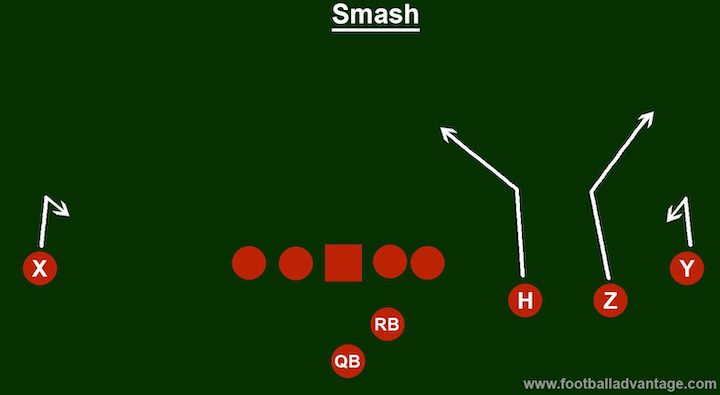
Smash is a play in which the two inside receivers will attack the deep part of the field, while the two outside receivers will run short routes.
This is a great play as it attacks the defense on multiple levels, and creates different looks on each side of the field.
Against zone, Smash usually sees the outside receivers having only one defender on them, with the safeties helping out on the deep routes.
This means that the outside receivers will have a lot of open space if they can shake that first defender.
On this play, the lone receiver on the left and the outside receiver on the right will run inside Hitch routes . The H will run a Deep Post toward the middle of the field, while the Z will run a Deep Corner toward the near sideline.
Play #2: Box

Box is a play that looks to cause confusion in the middle of the field.
By running three out of the four routes toward the middle, there will be many defenders running in front of each other and to the same place on the field.
It's easy for receivers to get lost among all these bodies, and then come out wide open as a result.
By having the two outside routes attack the deep area of the field, it leaves a lot of room for the underneath routes to run after the catch.
The X will run a Deep Post toward the middle of the field, while the Y will run a Go route down the right sideline.
The H will run a Shallow Drag from right to left, with the Z running a Dig/In route about 10 yards downfield.
Play #3: Skinny Post Attack
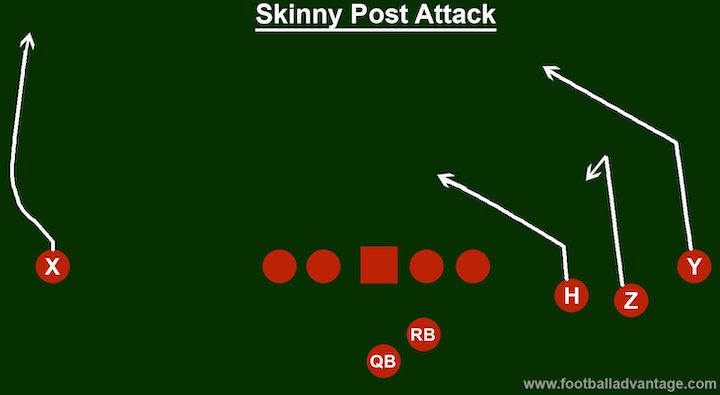
The Skinny Post Attack is great at attacking the defense at three different depths on the Trips side of the field -- all toward the middle of the field.
This often causes defenders to have to make a choice as to which receiver to cover -- especially the safeties .
Since the X on the outside will run a Deep Fade down the left sideline, he's often matched up one-on-one and could find himself free deep.
The X will run that Deep Fade down the left sideline.
On the Trips side, the H will run a Skinny Post , the Z will run a Deep Hitch, and the Y will run a Deep Post.
Play #4: Scissors
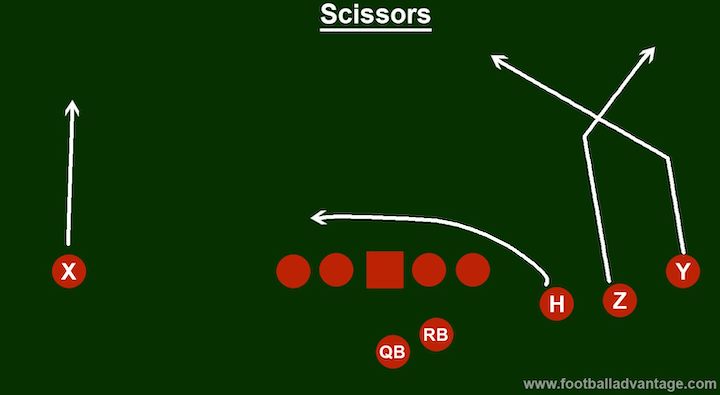
Scissors if the perfect example of how the Trips formation can use routes that cross each other to cause confusion.
In this play, the two receivers to the right in Trips will run mirroring routes that will cross each other at some point.
This will hopefully cause defenders to either run into each other, stumble trying to avoid each other, or just plain lose their coverage man.
Meanwhile, the two other receivers will run clear-out routes to take advantage of what should be a lot of free space.
The Y will run a Deep Post while the Z will run a Deep Corner .
The H will run a Shallow Drag while the X will run a straight Go route.
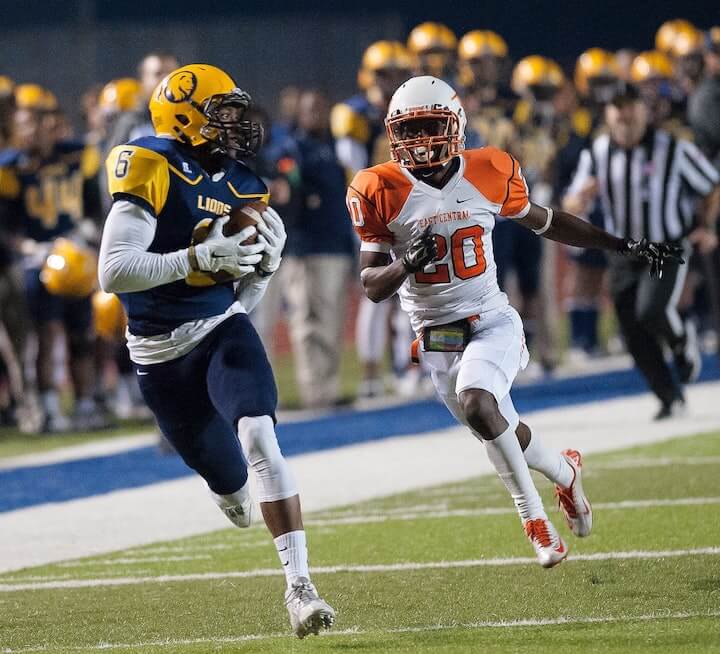
Many teams in today's game use the Trips formation, in some form, because of the many advantages it has.
While most offenses that use Trips will do so out of shotgun, it is a formation quarterbacks can use under center, too.
It causes a lot of confusion among the defense and creates great mismatches at just about every level.
What's more, it also helps to isolate one great receiver on your team, allowing him to often match up one-on-one against a defender.
Related Posts:
What is 21 Personnel in Football? (Full Explanation)
Singleback Formation (Coaching Guide With Images)
Pro Set Formation (Coaching Guide With Images)
Slot T Offense (Coaching Guide With Images)
Leave a Comment:
Save my name, email, and website in this browser for the next time I comment.
(0) comments
The ultimate guide to football defense, 15 fantastic defensive strategies (250 pages).
Enter your email below to get access for free:
100% Privacy Guarantee. Your email address is safe with me

Trips Formation Football
Football formations play a crucial role in the success of an offense. One such formation that has gained significant popularity is the Trips formation. In this comprehensive guide, we will explore the intricacies of the Trips formation, its advantages, and some of the best plays to run out of it. Whether you are a coach or a player looking to understand this formation better, this article will provide you with valuable insights and strategies to excel on the field.
Understanding the Trips Formation
Why the trips formation works, key elements of the trips formation, trips formation plays, 3. skinny post attack, 4. scissors.
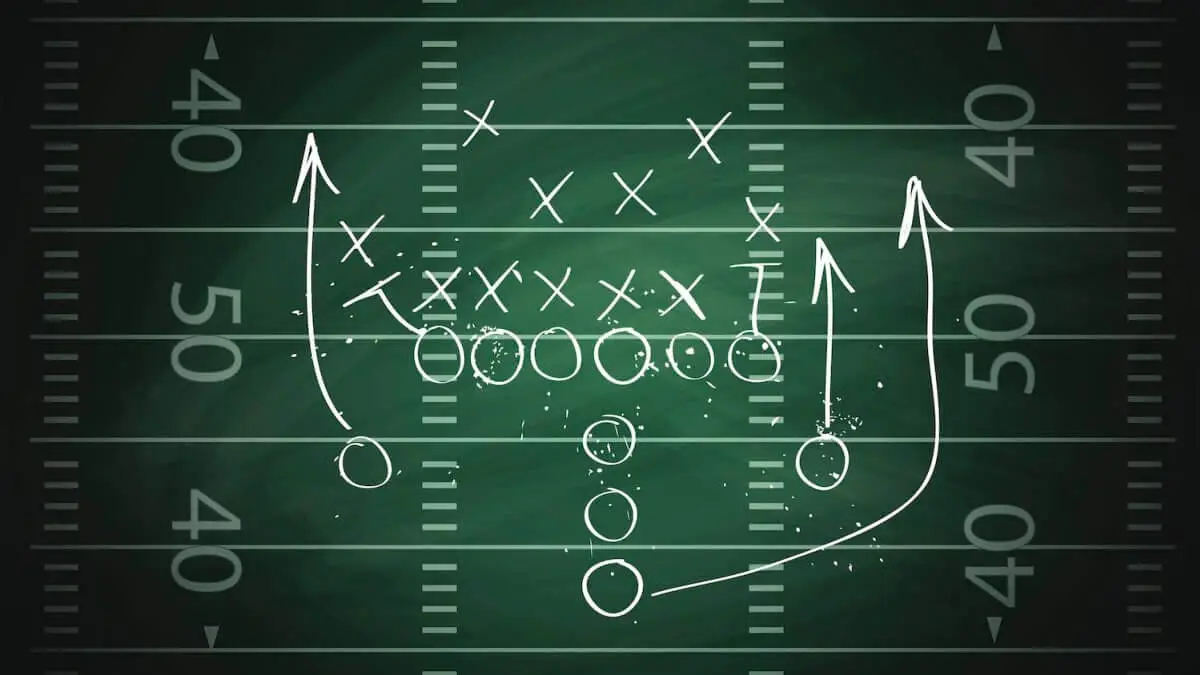
The Trips formation is characterized by three wide receivers lining up on the same side of the field. This offensive strategy, initially popularized by Joe Gibbs and the Washington Redskins, aims to create confusion and exploit defensive weaknesses.
The Trips formation proves effective due to its ability to create mismatches and flood the defense on one side of the field. By aligning three receivers in a clustered formation, the offense puts pressure on the defense to make challenging decisions. This formation forces the defense to either commit additional defenders to the Trips side, leaving other receivers in one-on-one matchups, or cover the Trips side with fewer defenders, creating opportunities for open spaces.
While the basic Trips formation features three wide receivers, there are variations and combinations that can be utilized to maximize its effectiveness. For instance, the “Shotgun, Trips right, slot left” formation indicates that the tight end and two wide receivers would line up on the right side of the field, while two receivers would line up on the left side of the field. The quarterback typically positions himself at least five yards behind the center, ready to execute the play.
To fully unleash the potential of the Trips formation, teams have developed a range of strategic plays. Let’s delve into some of the best plays commonly employed when utilizing the Trips formation.
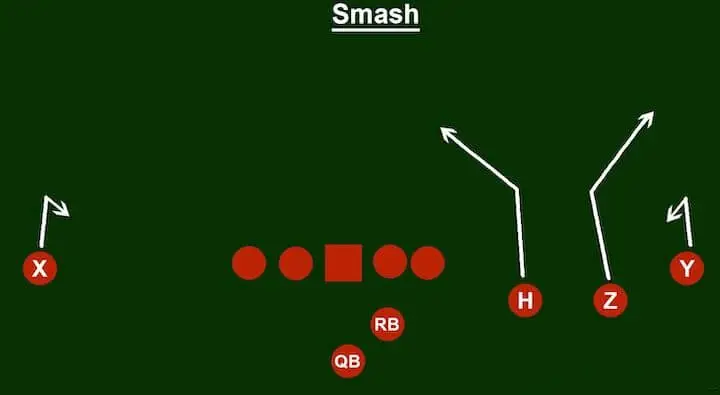
The Smash play is a versatile concept that provides answers against multiple coverages. In this play, the Trips side features a single wide receiver running a corner route, while the running back executes an arrow route into the flat. Meanwhile, the other receiver on the Trips side runs a deep dig route, and the remaining receiver runs a shallow cross.
The Smash play effectively exploits the defense by creating a high-low read for the quarterback. Against zone coverage, the outside receivers often find themselves in one-on-one matchups, with the safeties focused on deep routes. This play offers ample opportunities for receivers to find open spaces and make significant gains.
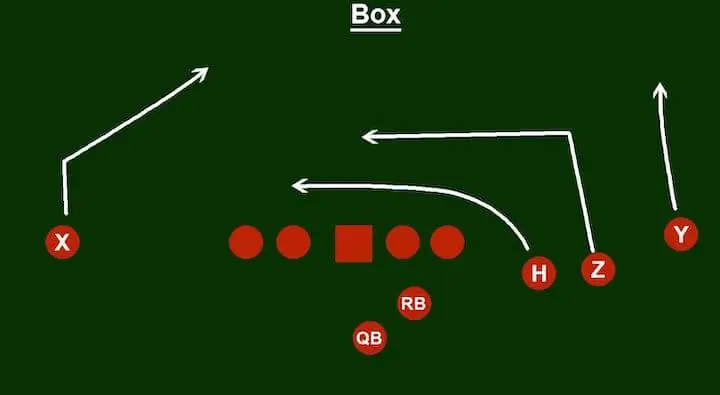
The Box play is designed to create confusion and exploit the middle of the field. By sending three out of the four routes toward the middle, the offense forces defenders to navigate through crowded areas. This play aims to create mismatches and open spaces for receivers to exploit after the catch.
In the Box play, the outside receiver runs a deep post route, while the other receiver on the Trips side executes a go route down the sideline. Simultaneously, the inside receiver runs a shallow drag route from right to left, while the remaining receiver runs a dig/in route about ten yards downfield.
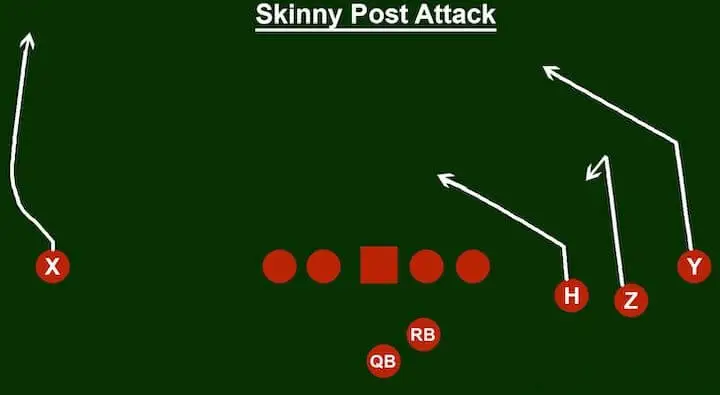
The Skinny Post Attack play is particularly effective at attacking the defense at multiple depths on the Trips side of the field. By stretching the defense vertically and horizontally, this play forces defenders to make challenging decisions in coverage assignments.
In the Skinny Post Attack, the outside receiver runs a deep fade route down the left sideline, often creating a one-on-one matchup. On the Trips side, the inside receiver runs a skinny post route, the middle receiver executes a deep hitch route, and the remaining receiver runs a deep post route. This play aims to exploit the open spaces and create confusion within the defense.
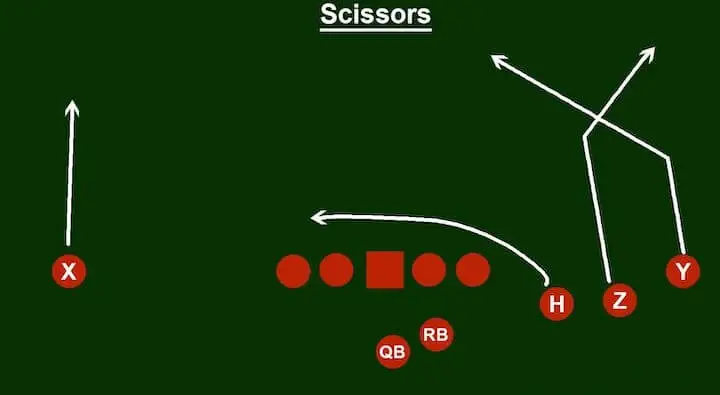
The Scissors play exemplifies how the Trips formation can utilize crossing routes to confuse defenders and create open spaces. This play involves two receivers on the Trips side running mirroring routes, crossing each other at certain points. The other two receivers run clear-out routes to take advantage of the free space created by the crossing routes.
In the Scissors play, the receiver closest to the line of scrimmage on the Trips side runs a deep post route, while the other receiver runs a deep corner route. Simultaneously, the receiver closest to the line of scrimmage on the opposite side executes a shallow drag route, and the remaining receiver runs a straight go route. This play aims to exploit the confusion caused by crossing routes and create opportunities for receivers to make big plays.
The Trips formation has revolutionized offensive strategies in football. Its ability to create mismatches, flood the defense, and exploit open spaces has made it a go-to formation for many teams. By utilizing plays like Smash, Box, Skinny Post Attack, and Scissors, teams can maximize the potential of the Trips formation and achieve success on the field.
Remember, the key to success lies in understanding the strengths and weaknesses of the defense and adjusting your game plan accordingly. With proper execution and creativity, the Trips formation can become a powerful weapon in your arsenal. So, get on the field, master the Trips formation, and dominate your opponents with strategic precision.

Hello, I'm Elvis Cook, the author of PlayfulFootball.com. As a former football player, I bring a unique perspective and firsthand experience to the content I create. Having played football myself, I have a deep passion and understanding of the game. My personal experiences on the field have shaped my love for football and ignited a desire to share my knowledge and insights with fellow enthusiasts.

- Privacy Policy
- Cookie Policy
- Terms & Conditions
- Skip to main content
- Skip to primary sidebar
- Skip to footer
Joe Daniel Football
Coach Simple. Play Fast. Win.
Joe Daniel / November 16, 2020
Cover 6 Defense | FBCP S08E07
Use a cover 6 defense to stop 3 by 1.
Cover 6 Defense is more widely known as Quarter-Quarter-Half Coverage. It is primarily used as an adjustment to trips formations and it’s going to be the subject of our deep dive in this episode of The Football Coaching Podcast.
The Cover 6 Defense is a combination coverage between Cover 4 and Cover 2. There are many ways to run Quarter-Quarter-Half Coverage. It largely depends on what your base coverage is and we’ll be breaking that down.

Playing Cover 6 Defense
The basics of Cover 6 Defense involve sliding the free safety over to the three-receiver side to play one deep quarter. The corner on the trips side plays another deep quarter.
On the single receiver side, one defender plays the deep half. Depending on whether you’re a base Cover 3 or a base Cover 2/Quarters team, it’s going to change how you play the single receiver side.
If you’re a Cover 2 team, you can use a corner force to play outside leverage of the single receiver. That helps to take away the isolated receiver.
For teams that play more Cover 3, the corner can play the deep half zone. Use your weak side force player to strengthen the coverage against the 4 verticals threat.
Attack Quarter-Quarter-Half Coverage
As we always do on the deep dive, we finish by looking at how you can attack Cover 6 Defense. Find out how to use 4 verts against a Quarter-Quarter-Half Coverage look. We also show how you can run the ball against Quarter-Quarter-Half teams out of your 3×1 formations.
There will be a lot of great tips for you on both sides of the ball in this episode so be sure to download and listen to this episode of The Football Coaching Podcast.
Where to Go From Here
If you want to learn more about the Cover 6 Defense and the Quarter-Quarter-Half Coverage that we’ve talked about in this episode or you want to learn more about how to attack Quarter-Quarter-Half Coverages out of the 3×1 formation, it’s time to check out JDFB Coaching Systems.
Right now, you can get trial access to JDFB Coaching Systems for just $1. You’ll have access to all 5 Complete Coaching Systems, plus the Private Message Board, the Chalk Talk archives and over 40 archive Web Clinics. Just click this link to start your trial access no: https://join.joedanielfootball.com/
- Defending Trips Formations on Episode 196 of The Football Coaching Podcast.
- Defending Sprint Out Passes from Trips Formations from the JDFB Quick Clinic.
- How to Defend Speed Option from Trips Formations is a good look at how to be sure your defense is sound against Trips formations.
- Watch this video on Curl Flat Concept from Trips to attack Cover 6.
Share this:
- JDFB Coaching Systems

Understanding the basics of Cover 7, Part 2: Trips checks and weakside calls

In Part 1 of this Cover 7 series , we went over basic coverages in the Cover 7 family against two-by-two sets and one trips (three receivers on one side) adjustment (Clip). In Part 2, we will go over the multiple trips checks and some weakside calls. Cover 7 is split-field coverages, meaning both sides of the defense could work independently of each other. Instead of just calling one coverage like “Cover 3,” a strongside call and weakside call have to be made.
Advertisement
Terminology and important information
Split field: The coverages in this family can work independently of each other, so there can be two different coverages called on each side.
Leverage: Where defensive backs are lined up in relation to the receiver they are covering.
Strong side: The side the defense declares the passing strength of the formation, usually the side with more eligible receivers.
Weak side: The side opposite of the side the defense declares the passing strength of the formation, usually the single receiver side against trips.
Numbering system: Defenses identify receivers with numbers; the receiver farthest from the ball is No. 1, second farthest is No. 2 and third is No. 3.

Positions (Nick Saban’s system)
CB = Cornerback M = Mac (middle linebacker) $ = Money linebacker (weakside linebacker) * = Star (nickel) FS = Free safety SS = Strong safety

Stubbie is essentially the trips version of 7-bracket. It’s the same as Stump but the strongside corner is pressed and plays MEG (man everywhere he goes) on the No. 1 receiver, so there is no “smash” call — it’s just straight man coverage for him. One of the working theories behind this defense is that offenses rarely ever throw to the No. 1 receiver on the trips side, so the defense is OK with covering him one-on-one.

Some teams prefer Stump as their trips-check in Cover 7, but Alabama prefers Stubbie. It has the talent at cornerback to man up with almost every receiver in the country. Playing with pressed corners closes space and gives the corner less to think about.

On this play, No. 1 went vertical, so the corner had to cover him without any expectation of help over the top.
No. 3 went vertical, so the star got his eyes on No. 2. No. 2 went to the flats, so the star covered him.
The $ backer posted No. 3 with his eyes on No. 2. The No. 3 receiver went over the top of him, so he let him go and zoned off.
The strong safety read No. 3 and was responsible for covering him because No. 3 ran a vertical route.

The star and $ bracketed the return route by the No. 2 receiver. The strong safety had tight coverage on the vertical by the No. 3 receiver. The corner had good coverage on the “go” route by the No. 1 receiver, but the receiver made a spectacular play and high-pointed the ball.
Sometimes, you have to tip your hat to the offense if it can routinely make difficult plays. However, defensively, you have to be OK with giving up those plays every once in a while. The tight coverage you get from pressing and executing man-match forces the offense to make plays in contested situations, and more often than not, the odds are against them.

Stump is essentially MOD (man outside and deep) but against trips. The corner to the trips side lines up inside and off No. 1, and he has No. 1 outside and deep. He can also start showing press and bail at the snap. If No. 1 runs a route underneath of 5 yards, he’ll make an “under” call or “smash” call, which would tell the star to take No. 1 on the underneath route.
According to Chris Vasseur, host of the “Make Defense Great Again” podcast , Stump was derived from Stubbie as a red zone defense to protect against corner routes from the No. 3 receiver, but coaches started using it outside of the red zone. Saban prefers Stubbie because he’d rather have his strongside corner play press coverage.

The star lined up outside of No. 2 but had his eyes on the No. 3 receiver. If No. 3 runs an outbreaking route underneath 10-12 yards, he’d rob the route. If No. 3 runs vertical or inside, he’d cover No. 2 but with outside leverage.
The $’s job is to “post” No. 3, meaning he doesn’t have to carry or lock onto No. 3 unless he runs underneath of him, which he has to try his best to prevent by walling him off. If No. 3 goes over the top of him, he doesn’t chase and just zones off.

Here, the No. 1 receiver ran a hitch underneath of 5 yards, so the corner made a “smash” call to alert the star to take No. 1. The corner then backed off to his deep zone. No. 3 didn’t go vertical, so the strong safety played inside and over the top of No. 2.
The $ dropped too deep, allowing No. 3 to go underneath of him on a drive route. Because No. 3 went underneath of him, he had to cover him.

The defense executed the coverage perfectly. The star covered No. 1 short while the corner and strong safety had a bracket on the vertical by the No. 2 receiver.
In Part 1, we talked about a “push” call if the defense gets a “fast 3.” Against trips, the defense could get a “fast 4” if an eligible receiver from the weak side runs to the flats right away to the strong side.

Here, the offense was in a three-by-one formation with the running back offset to the weak side. The defense was in Stump, so everyone had the same assignments as in the previous example.

The running back, who was designated the No. 4 receiver, ran to the flats right away after executing his play fake, so the $ had to push to the running back, who was technically the new No. 3, and the Mac had to push to No. 3, who was technically the new No. 4.

The $ covered the running back in the flats with outside leverage, and the Mac covered the tight end running a shallow route with inside leverage.
Weakside calls
Again, in the split-field coverage world, both sides of the defense can work independently of each other. Offenses love to attack the weak side of the defense by using strategies like singling their best receiver there or running pick plays. It makes the picture less muddy for quarterbacks because, with fewer players to that side, there are fewer factors of which to be cognizant. The defense needs to have a menu of calls to adjust to weakside concepts.
A common weakside concept against Cover 7 is to have the No. 1 receiver run an in-breaking route to “rub” the Mac linebacker covering the running back. To counter, the defense could make a “Connie” call, which is like man-match Cover 2 to the weak side.

Defenses will typically call this when they see the No. 1 receiver with a tight split, which could be a clue that the No. 1 is going to run an in-breaking route or try to rub the Mac.
In Connie, the Mac has the first inside release, while the cornerback has the first outside release.

When the ball was snapped, the corner opened up and “slow-bailed” so he could get vision on the No. 1 and No. 2 receivers and float outside in anticipation of a route coming outside.
The No. 1 receiver released inside right away, so the Mac took him while the corner got his eyes on the running back, waiting for him to release.

The Mac already had inside leverage on the drive route and was easily able to cover it, while the corner was outside waiting for the running back to leak to the flats. Notre Dame QB Ian Book looked to attack the weak side but was surprised by the coverage and ended up taking a sack.
Cone is the most commonly used weakside call. Cone is a bracket on the No. 1 receiver by the free safety and weakside cornerback. The free safety has inside leverage on the receiver, while the corner has outside leverage. If the receiver releases inside, the safety takes him and the corner zones off. If the receiver releases outside, the corner covers him and the safety zones off and is free to “poach” or help on the strong side.

Here, the Vikings appeared to have their version of Stubbie called. They had a safety playing the $ position. The safety and free safety had a cone bracket on Davante Adams on the weak side.

Adams ran a crosser, so the safety came off the roof and drove hard downhill to rob the route. The cornerback zoned off and helped on the strong side.

The corner helped cover the vertical by the tight end from the strong side. The $ covered the running back on the check release. The safety was able to get in front of Adams and intercept the pass. This play was a great example of how efficiently and tightly the defense can cover routes with man-match techniques.

“Dog” is simply 2-man on the weak side. The corner has MEG on No. 1, and the safety has a deep half zone and can read the quarterback’s eyes.

“Poach” and coverages like it are rare examples of when a defense isn’t truly a split-field coverage anymore because the weakside safety has coverage responsibility on the strong side. In poach, the weakside safety has to take No. 3 vertically. This allows the strong safety to just focus on taking the No. 2 receiver and frees up the star because he doesn’t have to carry the No. 2 receiver vertically.
Each type of coverage in the Cover 7 family is more effective at covering certain types of distributions than others. Together, they have the ability to make life difficult on any offense, no matter how and where it likes to attack. The tricky part is learning all the calls and adjustments and then executing. It’s difficult for the players on the field to process on the fly while covering talented offensive players, and we haven’t even gotten into motion adjustments yet, which is why reps are so important. Once it becomes second nature, man-match defenses could be smothering and frustrating to face, which is why you typically see Alabama defenses get better later into the season.
Former Alabama defensive backs coach Karl Scott’s Cover 7 clinic
Former Alabama defensive coordinator Jeremy Pruitt’s clinic on covering three-by-one formations
Nick Saban Cover 7 cut-ups from his time with the Dolphins
Cameron Soran’s “The Pass Coverage Glossary”
Recommended follows on Twitter for defensive content
Brian Vaughn Cody Alexander Chris Vasseur Kyle Cogan
(Top photo of Anthony Harris and Davante Adams: Hannah Foslien / Getty Images)
Get all-access to exclusive stories.
Subscribe to The Athletic for in-depth coverage of your favorite players, teams, leagues and clubs. Try a week on us.

Ted Nguyen is a NFL staff writer for The Athletic. He breaks down film to uncover the story that the X's and O's tell. He also covers the latest trends around the league and covers the draft. Follow Ted on Twitter @ FB_FilmAnalysis
- COACHING VIDEOS
- HOT PRODUCTS
- Commenting Rules

- Analysis Library
- Football Repository
Click Here To Enter The FishDuck Forum
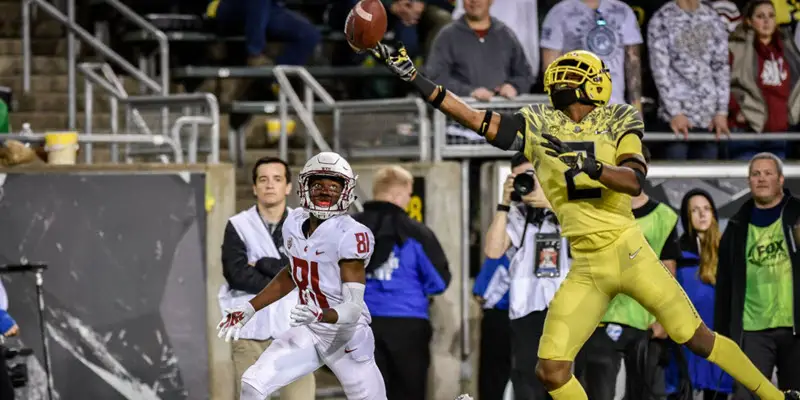
The Jim Leavitt 3-4 Defense: Trips Coverage with Two-High Safeties
Cameron Soran August 14, 2018 Analysis
In the previous post, we explained how Jim Leavitt ‘s 2-high safety coverage concepts operate for when there are two receivers to a side. Now we will be covering his 2-high safety coverage concepts for when there are 3 receivers to a side, most commonly known as Trips coverages.
The Trips Coverages
With 2-high safeties, Jim Leavitt will run: (a) Stubbie , and (b) a couple Poach coverages. Problematically, there were a lot of coverage breakdowns (i.e., missed assignments) when facing Trips , and as such, I could not identify another trips coverage than these from 2-high. I suspect then, that Leavitt did not install the entirely of his trips coverages in the 2017 season.

The “receiver key” numbering system for defenders.
Readers-note the numbering system of receivers by the defense above. This will be helpful as you read this and other analysis articles about coverages. The No. 1 is closest to the sideline and we count up in numbers on each side as we move closer to the center. Note the running back is considered the No. 3 receiver by the defense when counting on the right side for the defense, and the tight end is considered a No. 2 receiver when counting from the sideline inward on the left side.
Now to learn a few defensive terms you may not have heard. … Charles Fischer

Note the Apex (A) and Hook (H) defenders…
The Apex , (The “A” above on both sides) is the first underneath defender inside the cornerback. This can be the nickel DB, a linebacker, or safety that has rotated down, etc. The point is that the Apex is generally responsible for the No. 2 receiver (second eligible receiver – TE or WR – from the outside in). I use the term Apex because a lot of the same coverages will be the same regardless of who is playing the Apex position, whether it be a linebacker, safety, nickel, or a dime defensive back. I should acknowledge that many coaches use the term Alley for what I will be describing as Apex .
The term Hook , (the “H” above) which is the second underneath defender inside the cornerback. This is most commonly a linebacker, but can be a sixth defensive back or a safety rotated down into the box. Again, the point is that a Hook player tends to have run-first responsibility and is generally keying the running back in 2×2 sets.
Stubbie , as it is most commonly known, (below) is the most frequent trips coverage from 2-high in football, and Leavitt’s is no exception. Understanding that the least likely man to catch the ball in trips or trey is the outside receiver, defensive coordinators everywhere prefer to lock him down with only man coverage. Then it is effectively 2-Read coverage on the No. 2 and No. 3 receivers.
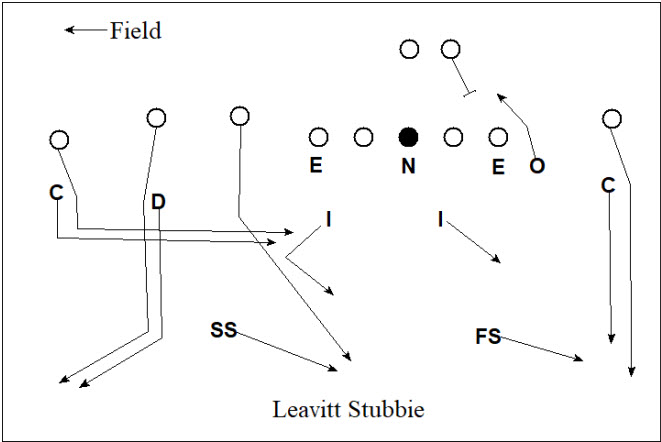
Leavitt “Stubbie” Coverage
Stubbie coverage means that the corner is man-to-man on the No. 1 receiver, and that the Apex, Hook, and Strong Safety will be playing 2-Read on the No. 2 and No. 3 receivers.
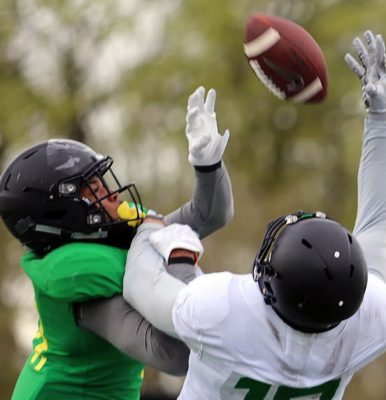
Thomas Graham wins another confrontation.
Strong Corner – Press alignment. MEG (Man Everywhere he Goes) on No. 1.
Strong Apex – Man on No. 2 for everything except when No. 3 is out or No. 2 runs under. If No. 3 is out, then take No. 3 man to man. If No. 2 runs under, then zone off.
Hook – If No. 2 or No. 3 runs under, then match that crossing route. Otherwise, wall off the No. 3 from the inside and take him to safety if he goes vertical.
Strong Safety – Take all of No. 3 vertical. If No. 3 is not vertical, then take/bracket No. 2 if he is vertical.
Weak Apex – Take any No. 2 weak. If no No. 2 weak, then take first crosser.
Weak Safety – Bracket any vertical routes by No. 1. If none, push to direction of where the quarterback is looking.
Weak Corner – MEG on No. 1.
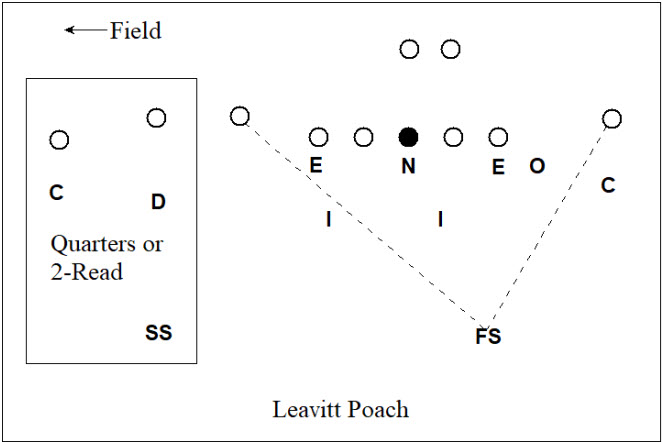
Poach coverages, sometimes called Solo coverages, are a series of related trips coverages that place the free safety in a Poach technique. Essentially, the free safety will work to rob (i.e., try to get an interception on) any passes to the No. 3 if and only if the No. 3 goes vertical. If the No. 3 is not vertical, then the free safety will work to rob any passes to the No. 1 if he is vertical. Poach coverages essentially aim to get the best of all worlds: if No. 3 is vertical, then you get an extra defender in the middle of the field to help there; but if No. 3 is not vertical, then you get an extra defender to help out against the weak No. 1 receiver.
One of the benefits of Poach coverages is that it gives the defense flexibility on how they want to play the strong No. 1 and No. 2. Given that Oregon’s corners will sometimes – though definitely not always – take No. 2 to the flat, I have judged that they have both varieties in their playbook. Leavitt seemed to use Poach, however, primarily to free up the weak safety in run support while remaining in 2-high.
Leavitt Poach Coverage

Jim Leavitt
Strong Corner – Play Quarters or 2-Read on No. 1 and No. 2.
Strong Apex – Take first man to the flat. If none, then play Quarters or 2-Read on No. 1 and No. 2.
Hook – Man on No. 3 except when No. 3 is out to the flat. If No. 3 is out to the flat, then zone to defend against No. 2.
Strong Safety – Play Quarters or 2-Read on No. 1 and No. 2.
Weak Apex – Take any No. 2 weak. If no No. 2 weak, then take first crosser .
Weak Safety – Play Poach technique: Rob No. 3 vertical, but if No. 3 is not vertical, then poach No. 1 vertical backside.
The above should serve as a brief explanation as to the 2-high trips coverages used by Jim Leavitt in 2017. But as I indicated earlier, I do not believe this is the full extent of 2-high trips coverages Jim Leavitt has in his playbook. I expect to see others in the upcoming 2018 season.
Cameron Soran Hillsboro, Oregon
Top Photo by Kevin Cline
Recent Defensive Analyses for Learning the Jim Leavitt Defense
Analysis 1: Understanding the Basic Structure of the Jim Leavitt 3-4 Defense
Analysis 2: The Jim Leavitt 3-4: Oregon’s Defensive Fronts
Analysis 3: The Jim Leavitt 3-4: Triangle Coverage with Two-High Safeties
Related Articles:
Cameron Soran is a practicing business attorney in Hillsboro, Oregon. While not a Duck fan himself, he is an avid fan and analyst of Pac-12 (and Notre Dame) football in his spare time. He is also a contributor at https://rileykolstefootball.com/. You can follow him on Twitter @cameronsoran
New 2024 FishDuck Publishing Schedule….
During the off-season the FishDuck.com publishing schedule will consist of articles on Mondays and Tuesdays. Do keep checking as new articles could be published during the week when a writer has something to say.
In mid-August of 2024, we will go back to the seven-days-a-week of articles during the football season as we did in the football season of 2023.
The Our Beloved Ducks Forum (OBD) is where we we discuss the article above and many more topics, as it is so much easier in a message board format over there. At the free OBD forum we will be posting Oregon Sports article links , the daily Press Releases from the Athletic Department and the news coming out every day.
Our 33 rules at the free OBD Forum can be summarized to this: 1) be polite and respectful , 2) do not tell anyone what to think, feel or write , and 3) no reference of any kind to politics. Easy-peasy!
OBD Forum members….we got your back. No Trolls Allowed!
- Posting Rules
- What is FishDuck?
- Terms of Service
- Privacy Policy
- Top Photo Credit

NEW This Week: The Big "O" System: A Streamlined Approach to the No Huddle - CLICK HERE

The Complete Guide to Offensive Football Formations
Posted by Throw Deep Publishing Staff on August 10, 2022
In this article we're going to explain not only the basic formations that you'll see from so many offenses in football, but also some wrinkles and gadgets, as well as some unusual formations that you might only see on a Friday Night from a high school team.
Before we get started, it's important to remember one thing: The language of football doesn't always make sense.
A lot of coaches use different words to describe the same thing, and so the names you're going to read about in this article are very generic, and not necessarily the name that a team will use for a formation in their offensive football playbooks.
If you're using these terms with a football coach or an extremely knowledgeable fan, it's almost a certainty that they will at least know what you're talking about when you say "Twins Formation" for example, even if they don't call it that.
Formation names are just a way to get offensive football players to line up in a certain way, so whatever your players can memorize best will work. There is more than one way to do it.
So let's get started...
Basic Formations
In this first section we'll talk about some very basic formations in football. Some are used more than others today, but you can still see their influence after so many years.
I Formation
The name for the I Formation is pretty straightforward- The running backs in the backfield are lined up behind the quarterback to look like the letter "I". This formation has been around for decades because of its simplicity, and all the ways it allows an offense to run the ball.
In this formation, you have the "tailback" (sometimes called the halfback) lined up the deepest in the backfield, and in front of him is the " fullback ". The fullback is usually much more of a blocker for the tailback, but some coaches like to see the fullback carry the ball quite a bit as well.

For example, one of the greatest college football teams of all time, the 1995 Nebraska Cornhuskers, won a national championship the I Formation as their primary formation. Their head coach Tom Osborne ran a triple option offense and everyone, including the fullback, was a threat to carry the football.
The advantage of the I Formation is that since the backs are lined up right behind one another, it makes it very easy to run the ball right up the middle with a blocker in front of the ball carrier. The offense can get the fullback to block on the middle linebacker in a hurry, and create a lot of space for the tailback to run between the tackles.
The I Formation is much more than a brute force running formation, however, as having three eligible receivers on or near the line of scrimmage allows the offense to create some legitimate threats downfield for the pass.
Split Backs Formation
Next, we go to the Split Backs Formation, where the backfield is split in half with a running back lined up on either side. The exact alignment depends on where the coach wants them to be.
Usually when an offense wants to run the ball a lot out of this formation, the running backs are lined up tighter to the inside, behind the two guards. This lets the quarterback take the snap and either hand it or fake it to a running back right away and threaten the defense with a run.

On the other hand, if an offense wants to turn it into more of a passing formation, the backs will be split out wider, behind the two offensive tackles, so that they can get out of the backfield quicker and start running pass routes .
You don't see this formation much anymore...
You're much less likely to see the split backs formation in a football game than you used to, at least in an NFL or college football game. The formation has almost gone extinct in modern football because most teams prefer to get a second receiver or tight end on the field instead of two running backs.
Those teams who do still use two running backs usually prefer to use the I Formation instead.
Still, if you find yourself at a high school game on a Friday night, there's still a chance you could see this formation pop up from time to time, either version of it.
Twins Formation
The Twins Formation is a term used to describe a formation where two receivers are lined up on one side of the formation, and there is only a tight end (or maybe two tight ends) lined up to the other side.
See the diagram below for a common example of the Twins formation.

You will note that the backfield is still lined up in the I Formation, and that's because Twins has a lot of potential formation variations.
Offensive coaches will sometimes use this formation to make the defense choose which side they want to focus on. If the offense wants to throw the ball, they have two receivers to one side of the formation. If they want to call running plays, they have a tight end and an extra blocking back who can go to the opposite side.
The idea is that you have a "flexed" side and a "tight" side that gives you the ability to run and throw the ball effectively from the same formation.
Another version of the Twins Formation, sometimes referred to as a "Wing Twin" formation, is shown below:

In this example, the offense has a pair of tight ends to the right, creating a "wing" side and a "twins" side on the opposite side. A lot of modern NFL and college football teams use this formation for the same reason they use the traditional Twins formation: They want to be able to present a credible threat to run and pass the ball, and putting that second tight end up near the line of scrimmage makes him an even more dangerous threat to go deep and catch a pass.
Spread Offense Formations
Now let's go through some formations that you're very likely to see during any NFL or college football game, and formations that make up a big part of what's known as the spread offense.
Ace Formation
This is a very generic name for this formation, but as we discussed in the introduction, most coaches will know what you mean when you say "Ace".

You're going to see some version of this a lot during games, since most modern offenses prefer to spread out the defense with multiple wide receivers. We'll go into more of the reasons for this in another article, but the idea is to create one-on-one matchups with the receivers, and leave fewer defenders between the tackles to stop the run game.
This formation is a staple of the modern spread offense, and just about every offense in football uses this formation in one way or another, since it's so versatile (it's not just a pass formation).
The tight end who is "attached" to the offensive line gives the offense the ability to run the ball, and the three receivers on the field (plus the tight end) gives the offense two eligible receivers on either side of the formation to throw the ball to.
It's also worth noting that the term "Ace" is a term that can be used to describe any "balanced" formation with two eligible receivers on either side. For example, if the tight end was split out wider and detached from the offensive line, a lot of coaches would still refer to it as Ace, like you see in the diagram below:
Trips Formation
Trips is the natural counterpart to Ace. Now you have three eligible receivers to one side, and a single receiver to the backside.

One of the benefits of this formation is that the defense now has to make a choice: Do they rotate the coverage toward the side with the most receivers? Or do they stay balanced and play the same to both sides. If you ask a defensive coordinator, he'll tell you the answer depends on who that backside receiver is.
If the single receiver to the backside of trips is one of the best players on offense, they probably don't want to leave him in single coverage, since that's what the offense wants.
Of course, it's not all about the passing game. This formation features a tight end who often times will be attached to the offensive line, giving the offense the ability to get the edge on the defensive line, and create leverage for whatever running plays the coach is trying to call.
The Trips Formation is another example of a formation that almost everyone runs in football in one way or another. Just like "Ace" it can be used as a generic term for any formation where the offense has three wide receivers to one side and one to the other.
You'll see an example in the diagram below of another version of what a lot of coaches will refer to as "Trips":

It can also include formations with multiple tight ends, like you see in the diagram below:
Empty Formation
The empty formation features five eligible receivers split out, lined up on or just a yard behind the line of scrimmage. This is another formation you're seeing more and more of these days with so much spread offense at every level of the game, and the empty backfield formation is definitely considered a spread formation, since it literally spreads defenses out as much as possible.

Coaches call it "Empty" because the quarterback lines up in the backfield as the sole man in the backfield. There are no other running backs lined up next to him or near him, so it's literally an empty backfield formation.
This formation used to be mostly a passing formation, where the quarterback would have to get the ball out in a hurry because he had very little pass protection. With only five offensive linemen blocking and no running backs, pass rushing defensive linemen have an easier time getting to the quarterback. As a result, the idea used to be that the offense would spread out the defense, find the mismatch or the receiver who was uncovered, and get it to him quickly.
That strategy still works, and teams still use it, but offenses have become better and better at pass protection, and the rules have changed to favor the offense more, so that teams have the ability to throw deeper passes (which take longer to develop and require the offensive line to block longer) as well as call creative running plays that take advantage of the holes that are naturally created in a defense by this formation.
Quads Formation
Speaking of the empty backfield formation, let's talk about another version of the empty set that often appears in the spread offense: The Quads Formation.
As you probably guessed, they call it quads because it gets four eligible receivers over to the same side, which forces defenses to make hard choices about who lines up where, and whether they are going to try to cover everyone.

Put another way, if the defense wants to put a defender across from all four wide receivers to the quads side, they can't really disguise that, so it really limits the different looks a defense can display.
Bunch Formation
The Bunch Formation is another generic term for any formation that features a 3-man alignment of wide receivers like you see below. Coaches refer to this as a bunch and it can create a lot of problems for defenses, especially when a team has several wide receivers that are tough to cover.

What makes the bunch formation especially dangerous for defenses is the ability for the receivers to cross paths just after the snap, and create confusion for the defensive backs.
Football offenses can use these types of formations to create picks or rubs for a receiver and to get him free against tight man coverage.
For example, if the Z receiver in the diagram below has a defender assigned to him in man coverage, and the two receivers inside of him get vertical quickly, all he has to do to elude the defender across from him is to release inside and underneath, and suddenly he's got enough open space to get open for a reception.

This is why the bunch forces defenses to spend time on it in practice, because you need special calls and combination coverages to be able to cover all the different ways a team can run pass routes from this alignment.
We'll go into greater detail on bunch formation pass plays in another article.
Backfield Formations
In this section we're going to talk about formations that aren't technically formations , but are still important to know and understand.
Shotgun Formation
So let's get this out of the way, the shotgun formation isn't really a regular formation- it's a backfield set (or a backfield formation).
What's the difference?
A formation defines all eleven offensive players on the field, whereas the "shotgun" only refers to the way the quarterback lines up in the backfield and receives the snap from center .
See the diagram below for the difference:

There are an almost unlimited ways to line up in a shotgun formation- You can line up with two running backs, one running back, or none at all, just like the empty backfield formation we discussed a moment ago. If the quarterback lines up deeper in the backfield (usually between 4-5 yards behind the line) so that the snap has to travel through the air from the center, that qualifies as a shotgun formation.
Most teams these days will line up in the shotgun with one running back lined up to one side or the other of the quarterback, and the other four eligible receivers line up near the line of scrimmage, but other times they can line up with two or more backs in the backfield as well.
This brings us to another version of the shotgun formation...
Pistol Formation
This might sound confusing, but the Pistol Formation is technically a shotgun formation, but is also classified as its own backfield formation. The difference is that the running back is lined up directly behind the quarterback, unlike the typical shotgun formation where he's lined up off to one side or the other.

The pistol was developed into its own offense by Coach Chris Ault, who liked to use the gun, but didn't like the way that it forced the running backs to line up differently than they would've if the quarterback was under center. This is important because it is harder to create a "downhill" run game that attacks the middle of a defense if your running backs are taking the handoff and starting with their momentum going side-to-side instead of vertically.
So instead, he decided to keep his running backs in the same spot as they would normally line up if the quarterback was directly behind the center, so that the offense could have the best of both worlds.
The running back would be able to come straight downhill, take the handoff and build up momentum to run right up the middle just like in a traditional formation, but the quarterback would be lined up deep enough to take the snap and have extra time to throw just as in the normal shotgun.
Coach Ault did not invent the pistol formation, but he was the first to develop it into a full-fledged offensive system when he was the head coach at the University of Nevada. His success with the pistol led other teams to study it and incorporate it into their offensive formations.
These days it's extremely common to see college football teams line up in the pistol to run and throw the ball. One of the disadvantages to this formation is that the running back starts deeper in the backfield, and directly behind the quarterback, so it is sometimes tougher for him to see the defense when he's supposed to be pass blocking, and get to where he's supposed to be.
Overall, it's a great tool to drive the opposing defensive coordinator crazy and make his life tougher.
Single Back Formation
The Single Back Formation is exactly what it sounds like. You've got one back in the backfield behind the quarterback.

Though there is no definite rule about the term, most coaches only call it a Single Back formation when the quarterback lines up directly under center.
Several of the formations we've already discussed can be considered a single back formation, including Ace and Trips, and this is just another word coaches use to add context to the description of a play and formation.

Old School Formations
In this section we're going to cover some formations that you're a lot less likely to see on an NFL Sunday or even from your favorite college football teams, but still get a lot of play at the high school levels and below.
Wishbone Formation
Let's start with the Wishbone Formation. The Wishbone is named for the unusual backfield formation that resembles, you guessed it, a wishbone.
You can make your own judgements based on the diagram below:

The Wishbone Formation is the basic formation of the Wishbone Offense, which we will cover in more depth in another article.
The three running backs in the backfield provide a lot of opportunities for misdirection, and this formation is often used to run all sorts of option running plays, which make it a perfect fit for the high school level where it is sometimes harder to find good passing quarterbacks.
Flexbone Formation
The Flexbone formation, sometimes referred to as the "Double Slot" formation, is the basic formation involved in the Flexbone offense.
The formation was developed from the Wishbone formation that we discussed above, but instead of three running backs lined up deep in the backfield, two of them are moved up closer to the line of scrimmage to create more of a threat for the pass as well as the run.

This formation typically features one of the running backs to either side (sometimes called an "A Back") put in motion to the other side, while the quarterback can open up and toss it to him, give the ball to the fullback (sometimes called a "B Back") or throw it downfield.
The Flexbone has been around for a long time, but one coach who is well known for running this formation and offense is Paul Johnson, who was the head coach at Georgia Tech until the end of the 2018 season when he decided to retire.
Double Wing Formation
The Double Wing formation is something you rarely see anymore, even at the high school level, but the teams who run it are very tough to defend. Some teams may use a version of this as strictly a goal line formation, but there are others who base their entire playbook out of it.

This formation features, you guessed it, a "wing" on each side of the formation, which is football slang for a blocker just off the line of scrimmage and lined up extremely close to the tight end. It also usually comes with incredibly tight "splits" by the offensive line, meaning that most coaches prefer their offensive linemen in this formation to line up as close together as possible so there is not even an inch of open space between them. This way, there is no open space for the defensive line to shoot through an opening and cause trouble in the backfield.
The double wing formation creates a lot of issues for defenses because of the ability for the ball to go in either direction, or right up the middle. Since the formation is balanced, and there is no numbers advantage to either side, the defense has no idea which way the ball is going until after the snap and a quick fake or handoff.
At first glance, the Double Wing formation may not look like anything special, but coaches who have tried to stop it will tell you it is one of the most challenging offensive formations to prepare for.
T Formation
The T Formation used to be the primary formation at both the college and professional level, but these days, when it is rarely used, it is mostly used as a way to beat a goal line defense.

Having three backs in the backfield allows for all kinds of misdirection, play action fakes, and quick handoffs, which is what the game relied on back when the rules weren't so advantageous for the pass game.
You won't see this formation very often unless you attend a lot of high school football games, but it still has an influence on the game today, as we'll see with the next formation we talk about.
Wing-T Formation
This formation is sometimes referred to as a Wing-T Formation. Even though the Wing-T offense features many different offensive formations to attack a defense, if an offense lines up this way, it will automatically be identified as a Wing-T offense.
The Wing-T was adapted from the old T formation that we just covered a moment ago, similar to the way the Flexbone formation was adapted from the original Wishbone.

The formation uses a lot of quick motion by one of the backs lined up close to the line of scrimmage, and can get the ball to anyone in the backfield, as well as creating a lot of opportunities for the play action pass.
The formation (and offense) was popularized by Coach Harold "Tubby" Raymond at the University of Delaware, and he used this as a primary offensive formation with the offense to win 3 National Championships and 300 total games during his tenure.
We will go into further detail on the Wing-T offense in another article, not to be confused with the Slot-T Offense .
You can learn more about different Wing-T formations here .
Power I Formation
The Power I Formation is typically used as a kind of goal line formation, adding an extra blocker to the backfield give an offense more of an ability to run the ball when the defense is expecting it.

This formation is much less of a pass threat, but as we've already discussed, any time you have this many running backs in the backfield, you can get very creative.
On the other hand, you could run something as simple as an off tackle power play, and you've got the numbers in the backfield to do it.
Single Wing Formation
To be clear, there are all kinds of different versions of a single wing formation, but this offense still influences today's game at all levels, and there are plenty of coaches who still use it as the foundation of their offense.
Just like the double wing formation has two "wings" as part of the formation, the single wing formation has just one "wing" and it's used to try to create leverage for the offense to block defenders and run the ball.

The single wing formation here is characterized by having multiple players in the backfield who can receive the direct snap from the center and threaten the defense in any direction.
As we'll see in the next section, this formation still has a major influence on teams that may not even use the single wing as part of their base offensive formations.
Gadget Formations
These are unusual formations that you don't see as often, but can cause defenses a lot of problems if used correctly.
Wildcat Formation
The Wildcat formation is a cousin of the old Single Wing offense that we'll discuss in more detail in another article. The traditional Wildcat formation features an unbalanced line and a player other than the quarterback taking the snap.
In the diagram below, the left tackle has been moved to the right side, while the tight end is playing in the spot where the left tackle usually lines up. This creates an unbalanced line, with extra run blocking ability to the right, but the ability to throw a pass to the tight end on the left.

It's a really crazy look, which is why it is tough to prepare for.
Why would an offense use the Wildcat? Well, for a couple of reasons:
First of all, you're usually lining up in a formation that is very different from most basic formations that a defense usually sees, or even that you usually see. If the opponent tries to line up in the typical defensive formations that they specialize in, they're vulnerable to the unbalanced side. On the other hand, if all the players at the defensive line shifted over to the unbalanced side, now you've got an opportunity to the opposite edge of the formation.
This is also effective because the guy taking the snap should be one of your most dynamic players. Instead of snapping it to the quarterback, and then either handing it to that guy, or throwing it to that guy, you're getting it in his hands as quickly as possible.
The Wildcat formation has been around for a very long time, but it got re-introduced to the general public as a hugely successful formation in 2008 when the Miami Dolphins used the formation to upset the New England Patriots early on in the season. The Dolphins continued to use it throughout the season, and partially due to the Wildcat, they won a division title after starting 0-2 on the year.
You can see highlights of the game here:
You don't need to be an NFL team to run the Wildcat. No matter what level you play at, it's an effective way to get the ball in the hands of your best player.
Emory and Henry Formation
The Emory and Henry formation gets its name from Emory & Henry College in Emory, Virginia, where it is believed to have originated. It takes the idea of a closed or unbalanced formation and flips it on its head.

This formation is very balanced, but it's also very unusual, with the players, including the offensive line, spread out for the full width of the field into separate pods, almost like a punt formation. The idea is that the defense will have trouble lining up correctly to one side or the other, or they'll over-adjust and leave room inside for running plays.
Even if the defensive line spreads out to account for the wider offensive linemen, and all you have left in the middle of the defense is a nose tackle , you can still run the ball up the middle.
You won't see this one very often, but every once in awhile a college coach who likes to get creative will pull it out of the bag of tricks, and the Cincinnati Bengals even used it on a regular basis when Marvin Lewis was the head coach.
You can see some examples of the formation in the video below:
Swinging Gate Formation
The Swinging Gate is a tricky formation that is typically used after the offense scores a touchdown, and the field goal team lines up in an unusual way that forces the defense to either line up to it properly or give up an easy score.
There is no "one way" to line up in this formation, since there are lots of different versions, but usually it looks something like what you see in the diagram below.

In this example, the offense has the option of either snapping the ball to run a trick play, or they can decide to line back up and kick the extra point if the defense doesn't give them the look they want. It is considered a very effective way to go for two points after a score.
This is not normally used in the middle of the field during a drive, but there is no rule preventing it.
Click the link to read more on the swinging gate formation .
Unbalanced Formation
An Unbalanced Formation features 4 or more ineligible players on one side of the center or the other.
A legal football formation consists of seven players on the line of scrimmage including the center, and most of the time this includes a guard and tackle on either side of the center, and finally an eligible player at the end of the line on either side.

We won't go too much deeper into football rules in this article, but a player is not allowed to catch a pass if he lines up on the line of scrimmage and he is "covered up" by someone else- meaning that there is another player lined up on the line of scrimmage outside of him.
When we talked about the Wildcat formation above, we gave you an example of an unbalanced formation. The left tackle lines up to the right side of the formation to give that side extra "beef" in the run game, and so now there are an unbalanced number of people on the right side of the line of scrimmage. This is a big reason why it is such a big part of the goal line offense for teams, especially in high school and college football.

Of course, just like a lot of these other formations we've covered, there are lots of ways to do it. Many times an offense may decide to move one of their wide receivers over and cover him u on the line of scrimmage, making him ineligible to catch a pass.
What's the point in lining up in offensive formations like this? It's true that a receiver won't be as good at blocking the run as someone who plays offensive line, but it still creates a strain on a defense. Sometimes the opposing defense won't recognize it.
This is a lot of information. If you're looking for a book of football plays , check out our library of great materials.
- Choosing a selection results in a full page refresh.
- Press the space key then arrow keys to make a selection.
- The Jump Set
RED ZONE RESCUE
Air raid base package, the quick game, maximizing the 3 x 1 formation, american football x's and o's, free football coaching resource.
- Coach Bill Russell
by Doug Heslip
The trips formation has multiple combinations of plays that can give a defensive coordinator coverage nightmares.
The 3 x 1 formation is an offensive set that puts your best athletes in a position to use their explosive movements in space. The quick slant on the single receiver side puts the defensive back on an island. The defensive back will be asked to tackle a receiver in open space.
The three-wide receiver side has endless combinations. An offensive coordinator can run highly effective screens, flop calls, and running plays that use motion to put your offense in high gear and destroy any defensive scheme.
To become a precision-timed passing attack, your quarterback and wide receivers will have to put in endless repetitions. Timing is critical. The shotgun snap must ignite the play. The snap has to be crisp and accurate to the quarterback. If the snap is low, high, or off to the side, the timing of the quick passing game will be compromised. Once the quarterback receives the snap, he must find the laces of the ball while making his read downfield. Once a decision is made, the quarterback must fire the ball with laser-like accuracy. MAKING IT WORK
I have my quarterback and wide receivers throw and run routes on air. This will give them an understanding of why timing is paramount. Depending on your age level, this may take weeks to perfect. I then add a defensive back and work on different scenarios the DB may use such as using an inside shade to take away the slant. When I detect that my quarterback and wide receiver have confidence in beating a defensive back, I add an entire defensive unit. I will review possible scenarios the defensive unit will try to create (See base formation – Diagram 1).
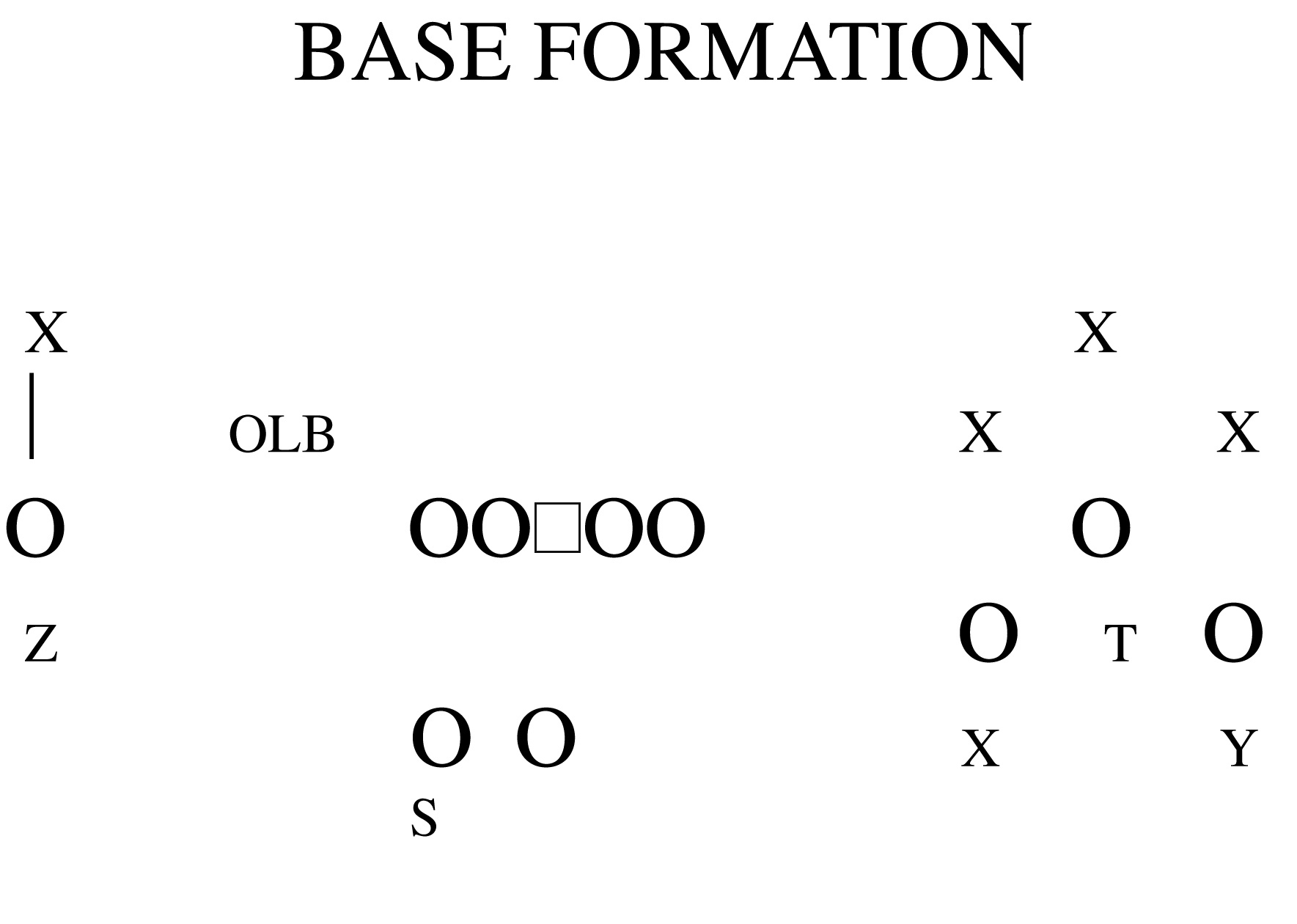
Diagram 1: Base Formation
To execute the quick slant, the first thing the wide receiver has to do is come out of his stance like a rocket. This will cause the defensive back to backpedal thinking the wide receiver is going deep. On the third step of the slant, the receiver “sticks” his route. A stick move is a pressure step by the right or left foot depending on what side of the field the receiver is on. This pressure step will give your receiver an explosive base to accelerate into the slant.
I watch the cornerback closely, because he will start to jump the slant in an attempt to intercept the pass. Once I see this, I call for the slug-go route. This means the wide receiver will accelerate into his slant via the pressure step. He will then take three more steps and stick his route again and break vertically upfield. The quarterback pump fakes after the first stick move. The defensive back usually bites on the slant as the wide receiver accelerates upfield. The defensive back is now out of position from jumping the slant so he will never recover as the receiver should score an easy touchdown. THREE- RECEIVER SIDE All wide receivers must explode out of their stances. The three-receiver side starts with the X receiver, who is lined up five yards from the tackle and offset approximately four yards off of the line of scrimmage. The X receiver runs a nine route which we tag as the Home Run Shot. The X will also help occupy one of the safeties in cover two. I am hoping the safety nearest the single receiver side will cheat over to defend against the Home Run Shot.
The T receiver will line up on the line of scrimmage five yards away from the X receiver. The T receiver will run a 12-yard corner route. The T receiver will be the least likely to receive the ball.
The Y receiver will line up five yards from the T receiver and off the line of scrimmage approximately four yards back. The X and Y should line up directly across from each other. The Y receiver will run a four-yard drag route. The four yards is reached after crossing the line of scrimmage. The Y will use a speed cut break into his route and run underneath the linebackers. This route is usually wide open. Lately, I have been using an explosive receiver to run the drag because no one accounts for him on the defensive side until the ball is caught.
I will also use a flop call. This tells the Z and X receivers to flop positions. I like the Z and X to have similar body types. A flop call is typically used in the second half after adjustments are made by the opponent.
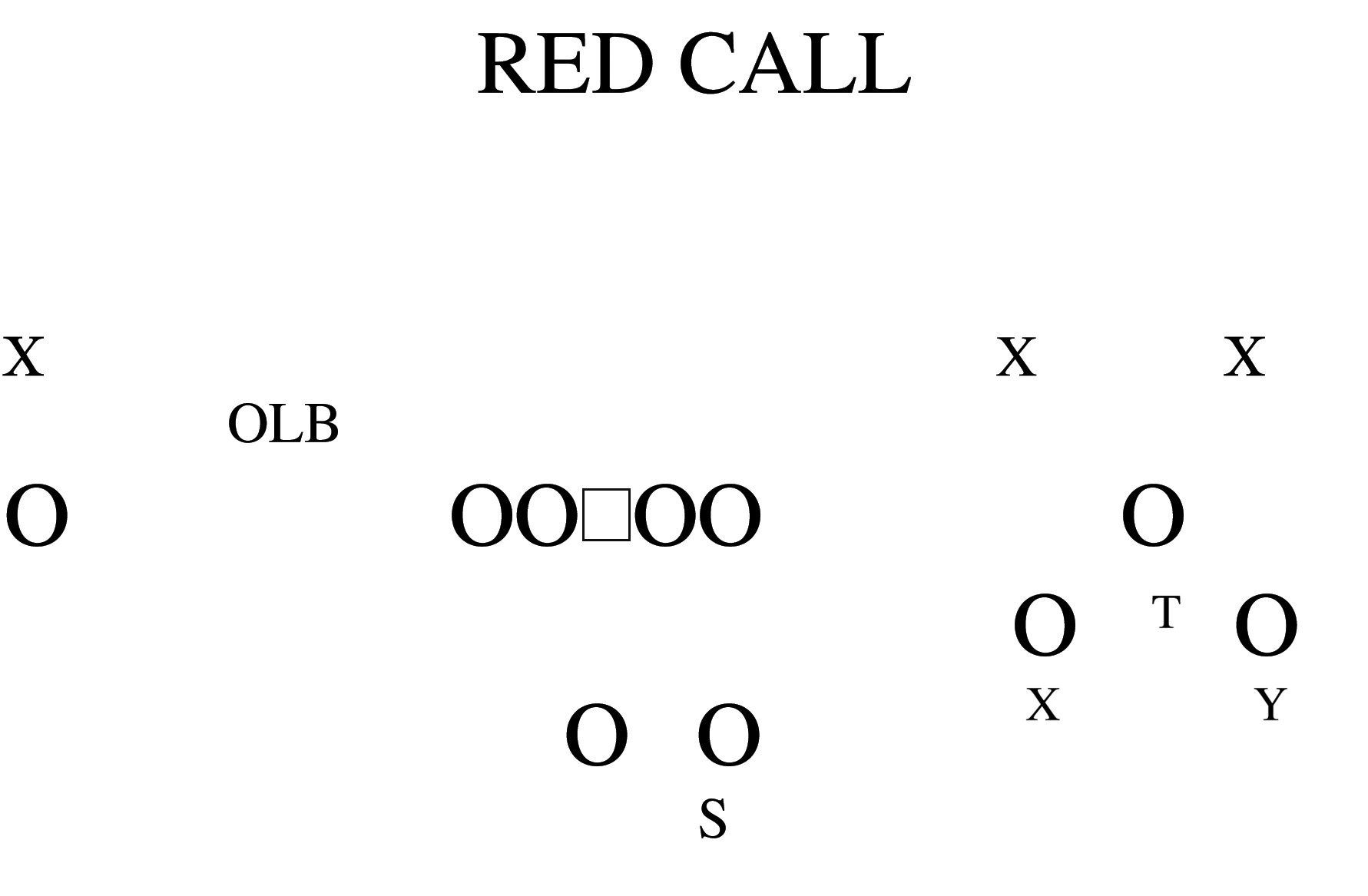
Diagram 2: 3 X 1 Block Screen
I will also run a screen from the three-receiver side (See Diagram 2). I target the Y receiver and use the X as a blocker. The Y receiver will take three steps forward and then retrace his steps backwards. The quarterback will throw the ball to the Y receiver. The X receiver will abandon the Home Run Shot and block the cornerback assigned to the Y receiver. The T receiver will block his cover down. This means the defender over the X receiver has a lot of ground to cover to tackle the Y that just caught the ball. KEYS When the quarterback breaks the huddle, he immediately looks to locate how many safeties there are. If there is one safety in the middle of the field, I do not worry about him to the one-receiver side. In this case, the quarterback would locate the outside linebacker. If the linebacker drops to cover the slant, the quarterback hits the running back running a swing route to the one-receiver side. If the outside linebacker runs to the swing route, the quarterback will throw to the slant.
If the quarterback notices that the defense has only two defenders covering the three-wide receivers, the quarterback adjusts the running back to the three- receiver side by yelling ‘Red.’ A Red call tells the receivers on the three-receiver side to abandon their routes and block the defender in front of them (See Diagram 3). We now have a numbers advantage to the three-receiver side. The quarterback throws to the running back who is running a swing route to the three-receiver side. We now have four against two.
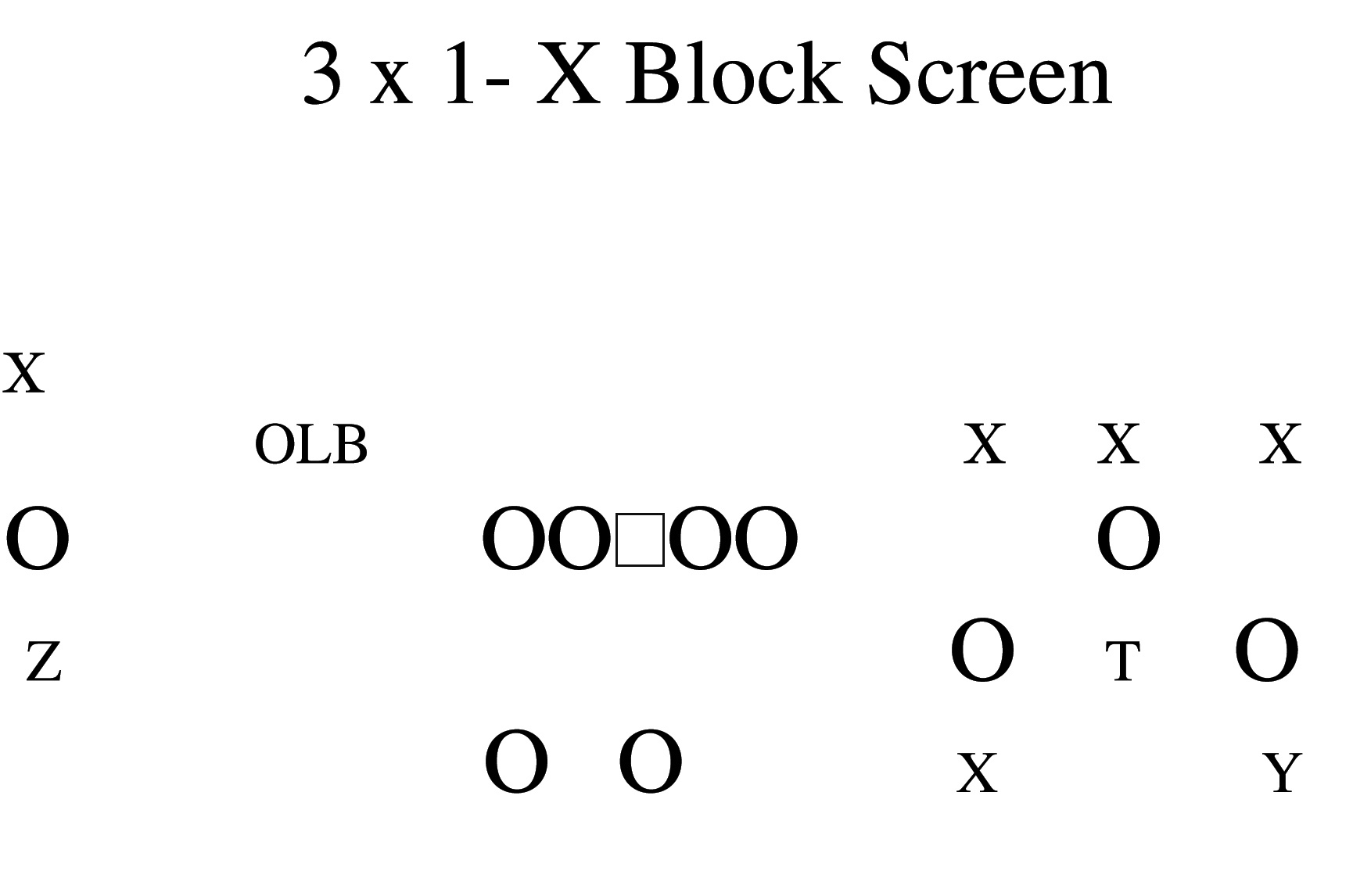
Diagram 3: Red Call
We will also try to sneak the running back to the tight end position on the three- receiver side. This means the T receiver has to move off of the line of scrimmage slightly to make the running back eligible. Everything looks the same except there is no running back next to the quarterback. The running back will run straight down the field and look for the ball just past linebacker depth. If the defense is in cover two, the running back splits the two safeties. I am hoping the safety nearest the three receiver side will commit to the T receiver who is running the 12-yard corner. OFF-SEASON THROWING To perfect the quick passing game I feel you need to start throwing in January. This means getting your QB, wide receivers and your center together to work on the timing from snap to throw to catch. Your quarterback needs to set aside additional time to perfect his footwork.
As for the wide receivers, the hardest thing to get into their heads is to explode like a rocket off of the line of scrimmage. They must, without exception, be drilled constantly to explode from their stance. Your receivers must run precise routes that will enable them to defeat one-on-one battles with the defensive backs that are covering them.
Your center must, without exception, be a part of the off-season passing routine. The center must understand he is vital to ignite the play and the timing begins with him.
The off-season is an excellent time to practice different scenarios such as the two- minute offense, blitz reads, sight adjustment routes, and last play of the game routes. This high octane passing game cannot be implemented in August. The efficiency and accuracy of this precision timed passing attack will not yield touchdowns as it would if tuned up properly during the off-season. About the Author: Doug Heslip is a Team USA Canton, OH assistant football coach and former Head Coach at Gwinn High School (MI). He has 15 years of coaching experience and is the founder of the ‘Hitch It and Rip It’ football camps. Heslip also serves as a member of the Congressional Youth Advisory Board.
Sign Up for the Play of the Week Newsletter
MORE OFFENSE
POWER PLAY (GAP SCHEME) 3 Drills to Improve Your Passing Game Packaging Plays Part III Packaging Three Concepts Together Packaging Plays Part II Packaging Basic Run Plays with Short Passes and Screens The Double Gun System A Unique Combination of the Double Wing and Shotgun Formations
OFFENSE VIDEOS
Maintain a Power Run Game From Spread Formations The Quick Passing Game – A ‘Check With Me’ System Made Easy The Pistol-Flex Triple Option – Introduction and Philosophy
MORE X’s & O’s
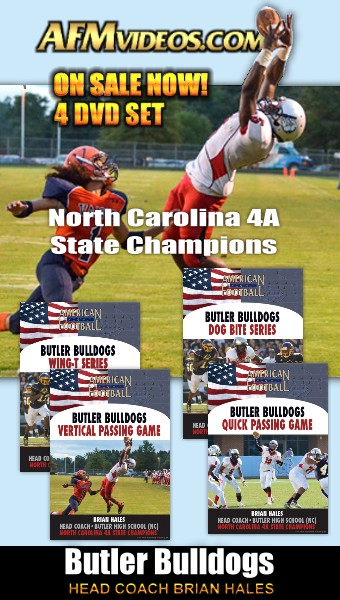
- Click to print (Opens in new window)
- Click to share on Facebook (Opens in new window)
- Click to share on Pocket (Opens in new window)
- Click to share on Twitter (Opens in new window)
- Click to share on Tumblr (Opens in new window)
- Click to share on Reddit (Opens in new window)
- Click to share on Pinterest (Opens in new window)
- Click to share on LinkedIn (Opens in new window)
Related Posts
Shallow cross, package plays part 2, how to package plays.

Youth Football Online
The Promotion & Instruction of Youth Football
YFO Newsletter Signup
Follow on social media.
- Offensive Line
- Quarterbacks
- Receivers/ Tight-ends
- Running Backs
- Passing Concepts
- Blocking Techniques
- No Huddle Offense
- Defensive Line
- Linebackers
- Defensive Backs
- Pass Coverage
- Kicking / Return Game
- Kicking Technique
- Special Teams Plays
- Offensive Line Drills
- Quarterback Drills
- Running Back Drills
- Wide Receiver Drills
- Defensive Line Drills
- Linebacker Drills
- Defensive Back Drills
- Best Youth Football Plays
- Plays-Offense
- Offensive Systems
- Plays-Blitzes
- Defensive Systems / Blitz Packages
- 7v7 Flag Football
- Youth Football Virtual Clinics
- Speed and Agility Training
- Strength and Conditioning
- Youth Football Training
- Practice Planning
- Football Parents
- Playbook Bundles
- Virtual Clinics
- 10 Best Flag Football Plays | 7on7
Home / Uncategorized / Defending the Trips Formation | Special Coverage
Defending the Trips Formation | Special Coverage
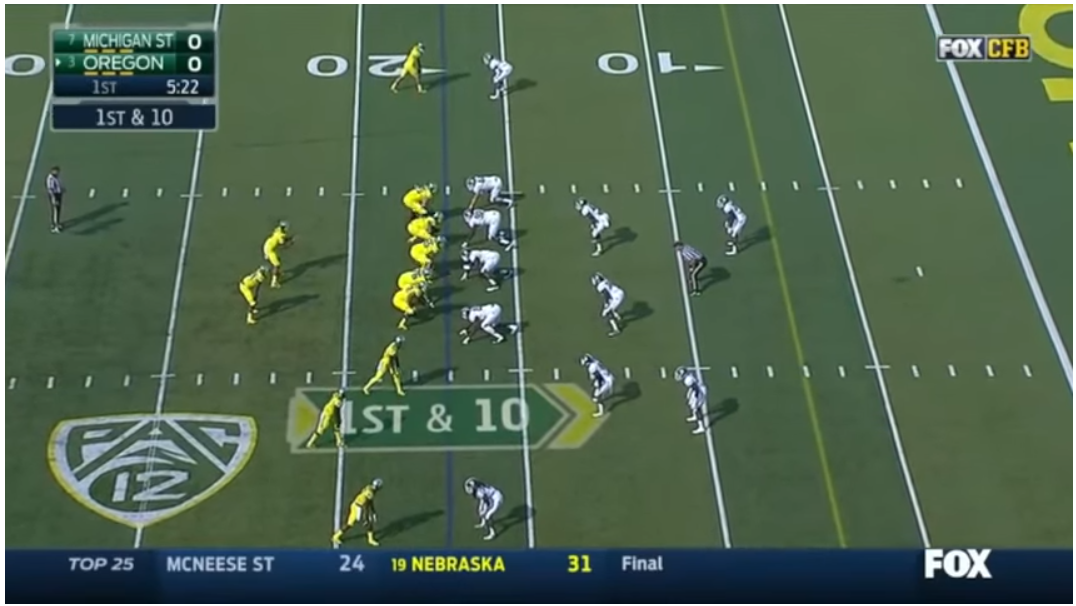
As offenses move to more wide open formations it’s important that defenses have the ability to respond to these formations. One of the most popular formations in football is the Trips formation. The Trips formation has three receivers to the wide side of the field and one receiver on the backside. This is also known as a 3 x 1 formation.
To defend the Trips formation it’s important to understand how the offense is using the formation. The goal of the formation is to overload the wide side of the field. If the defense does not adjust to this they can use their numbers advantage to attack the wide side. If the defense does adjust and rotate players over, then the offense will look to attack the backside with the isolated receiver.
As a result the defense is put into a position where theymust make a decision. They have to either commit to the three receiver side and rely on one on one coverage to the backside receiver or try to stay balanced and make the offense beat them with the three receivers. This is not a position that many defensive coordinators like to put themselves in.
The solution to this problem is to create hybrid players who are accountable to both the frontside and the backside of the pass defense. Essentially the defense is looking to steal a half player to play a specific route to the three receiver side while at the same time having responsibility covering the single receiver side. The best way to do this is through a coverage known as Special Coverage.
Special is a great way to get an extra defender to the three receiver while remaining sound against the single receiver. Special coverage all starts with the backside cornerback. He will be playing a modified man coverage. This means that he will be guarding the single receiver in man coverage unless the receiver makes an immediate cut to the inside. The definition of immediate changes for each defense but a safe way of defining it would be any in cut at or before his third step. The thing the cornerback has to watch out for is a slant by the receiver and then a wheel by the running back out of the backfield.
While this is a man coverage it is not a press coverage. The cornerback needs to play a little off to ensure that he can’t get beat deep, especially to the outside. The way many teams will attack this is to throw short passes to the single receiver on a hitch or similar route and force the cornerback to make the tackle. If he does make the tackle the offense has gained 6 yards and if he misses the tackle there is a big gain. This is where the backside linebacker has to get involved in covering the pass game. His goal, after he has ensured it’s a pass, is to get underneath the hitch pattern and disrupt the throw. This makes Quarterbacks and coordinators nervous because of the potential for an interception.
The backside safety also plays a crucial role in this coverage. The backside safety will play in the middle of offensive line at about 10-12 yards deep. He is responsible for any vertical route from #3 on the 3 receiver side but is also responsible for being the force player (outside run support) on the single receiver side. This player must be very talented and understand the game. While the coverage starts with the backside cornerback it is the Safety who make the coverage sound against both the run and the pass.
The front side of the coverage is essentially a Cover 3 look. In this look the Cornerback has the deep third. While he must ensure no one gets behind him he can afford to start closer to the line to disguise the coverage. The frontside safety is rolled down and is responsible for the sideline flat. One option that the players have is to make an opposite call. On this call the Safety is responsible for the deep third and the Cornerback takes the flat. This can be an effective change-up and makes for a great way to stop the bubble route.
The Nickel or Sam linebacker has the hook curl area to the three receiver side. He will line up by apexing the end man on the line of scrimmage and the #3 receiver. While he has run support to the D gap he also must make sure that the #3 does not get a free release up to the Safety. If #3 is able to get a free release to the safety it allows the offense to get into the Four Verticals concept that is designed to take advantage of single high safeties. If the offense is using this #3 to get vertical consistently the defense can switch to a special stay coverage. In this coverage everything remains the same but if the #3 receiver runs vertical the nickel will guard him man to man. The downside of this is it opens up the hook/curl passing zone. It makes for a good change up but should not be a base coverage.
The Special Coverage is a great way for the defense to take away the offense’s advantage on the three receiver side. Like anything it has strengths and weaknesses but if the backside cornerback and safety are capable of performing their jobs the coverage can really frustrate offenses.
(See Also) Cover 4 Pattern Matching

T Formation Offense Clinic

Easy Completions Clinic

Elite Football Playbook Bundle | Best Sellers

Power I Formation Football Clinic

Single Back Formation Clinic 2024
Recent articles.

Contribute Content
All children will learn life lessons from participating in youth football. Join our Movement today.
Returns + Exchanges
Terms and conditions.
YFO Selected as a Hudl Top 100
Youth football parents, yfo all stars.
* indicates required

Copyright ©2023 Youth Football Online. All rights reserved.
Football Toolbox
Passing Game Formations Part 2
February 28, 2017 by
This post is a follow up to Passing Game Formations Part 1
Installing Formations and Backfield Sets
Trips Right / Left Gun Trips Right / Left Pistol Trips Right / Left
The difference between Trips and Orange is the alignment of the Tight End. In Orange you get three receivers to the Tight End. With Trips you get three receivers away from the Tight End.

Trey Right / Left Tight Gun Trey Right / Left Tight Pistol Trey Right / Left Tight
In a Trips formation the “X” and “Z” align to the same side.

Trey Unbalanced Right / Left Tight Gun Trey Unbalanced Right / Left Tight Pistol Trey Unbalanced Right / Left Tight

Bunch Right / Left Gun Bunch Right / Left Pistol Bunch Right / Left
The difference between Trips and Bunch is the alignment of the receivers who have now tighten their splits from each other and now the “Z” is aligned outside the “X” receiver.

Cluster Right / Left Gun Cluster Right / Left Pistol Cluster Right / Left

Javelina Right / Left Gun Javelina Right / Left Pistol Javelina Right / Left
Javelina puts the “X”, “Z”, and the Tailback in a stack position opposite the right and left call. You can call this formation any name you would like.

Gun Quads Right / Left Gun Quads Right / Left
Quads formation puts the receivers in the same mode as the Trips formation except for the Fullback will follow the quads look.

Diamond Right / Left Gun Diamond Right / Left
The Diamond formation places the Tight End up front in the Diamond and 10 yards outside his tackle. The “Z” and “3” align 2 yards from the Tight End.

Wacky Right

About the Author of this post:
Jerry Campbell has over 30 years of high school and college coaching experience. He has experience as a head coach, offensive coordinator, and various position coaches. He has written numerous football coaching articles in various publications, is the author of over 30 books on coaching football, and has produced 12 coaching video series. Additionally, he is a nationally sought after speaker on the coaching clinic circuit.
- Special Teams
- Training & Conditioning
- Intangibles
- Program Building
All-22 Film Breakdown: Defending Trips-Bunch Formations
During the summer, the best thing a casual fan can do if they want to learn more about football is study as much as possible. With the access to All-22 Coaches’ Film and streaming sites, the ability to watch film to learn blitzes, coverages, and general play concepts, everyone should take advantage. Throughout the last several weeks, I’ve become obsessed with how defenses attack a trips-bunch formation.
Watching a great secondary is extremely interesting, from man-to-man with a single high safety to zone coverages with defenders responsible for walling off crossers. There are plenty of ways to attack and adjust defensively against 3×1 out of 10 or 11 personnel.
[visual-link-preview encoded=”eyJ0eXBlIjoiaW50ZXJuYWwiLCJwb3N0IjoxOTM3MCwicG9zdF9sYWJlbCI6IlBvc3QgMTkzNzAgLSBCdWZmYWxvIEJpbGxzIFRyYWluaW5nIENhbXAgUHJldmlldzogRml2ZSBCb2xkIFByZWRpY3Rpb25zIG9uIERlZmVuc2UiLCJ1cmwiOiIiLCJpbWFnZV9pZCI6MTk1MzQsImltYWdlX3VybCI6Imh0dHBzOi8vd3d3LmNvdmVyMS5uZXQvd3AtY29udGVudC91cGxvYWRzLzIwMTgvMDYvVVNBVFNJXzEwNDk3ODQxLmpwZyIsInRpdGxlIjoiQnVmZmFsbyBCaWxscyBUcmFpbmluZyBDYW1wIFByZXZpZXc6IEZpdmUgQm9sZCBQcmVkaWN0aW9ucyBvbiBEZWZlbnNlIiwic3VtbWFyeSI6IiIsInRlbXBsYXRlIjoiZGVmYXVsdCJ9″]
I began watching the Patriots’ defense because of Matt Patricia, the new head coach of the Detroit Lions – a team that I’m especially interested to watch. I specifically watched how he defended these trips-bunch formations. While he is one of the brightest defensive minds in football, when matched up against an equal competitor in offensive coordinator Matt Nagy, Nagy and QB Alex Smith got the best of him.
The Patriots appear to play man to man coverage versus the Chiefs, and that is too simple a coverage to play against the veteran QB, especially when you have a beautifully designed play like this. Pre-snap, Smith sees the single high set. Now he has to determine if it is man or zone coverage. If it is zone coverage, it is likely cover 3, at which point Smith will likely attack with the ‘All Verticals’ concept built into the play. If man coverage, Smith will target the ‘Mesh’ concept. Based on the ‘corners over’ look, where both corners are to the side of the receivers AND the Patriots’ safety Devin McCourty (No. 32) showing man posture over Chiefs tight end Travis Kelce, it shows as man coverage.

Starting cornerback Stephon Gilmore (top) is at a disadvantage. While the other two defensive backs can easily get into ‘phase’, Gilmore has too much green between himself and the #1 WR once the ball is snapped. But he is expecting to get a little help, a little interference, from the linebacker who is the ‘Rat’ defender. That linebacker, Kyle Van Noy (No. 53), is responsible for reading the QB, directing traffic, or disrupting any crossers coming over the middle.

On the snap, Smith looks to his right and confirms that it is man coverage. As he is taking his drop, his shoulders are pointing to his right, which moves Van Noy just a bit, and wide receiver Tyreek Hill is uninterrupted as he runs the shallow drag. Smith delivers, and Hill is able to gain some yardage after the catch.
Below is another example of how teams can choose to defend bunch formations. On this play, Buffalo shows man coverage across the board, but post-snap it shows a little differently. Only CB Tre White (M2M over the point WR of the bunch set) is in man coverage against the bunch set. The other two corners are pattern matching.

The outside cornerback WR will match any out-breaking route, and the slot corner will match against any in-breaking route.

The linebacker to the field will drop into the ‘rat’ role, help out versus any quick in-breaking routes, but ultimately read the QB’s eyes as the offense runs a ‘Snag/Spot’ concept. On the backside of the bunch set, Buffalo matches their safety vs. the #1 receiver to the boundary and their linebacker vs. the running back to round out the coverage. The coverage is beautifully executed, and the Bengals have nowhere to throw.
Cover 3 “Buzz” Against Trips-Bunch Formation
Offenses don’t always line up in their primary formation; teams will move to a bunch set in order to get the defense in a coverage that may not defend the formation well. That’s why most teams have a check/audible any time a team motions to trips — but not here. Buffalo trusts their base coverage because they are schooled well in it. They played Cover 3 more than any other coverage this past season. The Bills have three defensive linemen with the right defensive end in a wide-nine technique. Linebacker Lorenzo Alexander, No. 57, is the fourth rusher, coming on a delayed blitz. The secondary drops into a Cover 3 buzz look.

When Alexander blitzes, Preston Brown (No. 52) sells a fake blitz before dropping into the middle zone, where he has a hook-curl responsibility. Ramon Humber is pattern matching, which is essentially a zone coverage that turns into man if a receiver enters his zone.

As you can see, the defense works in synergy. Both cornerbacks defend the outer third of the field while the free safety, Jordan Poyer, drops to cover the deep middle third of the field. This is Cover 3, but with a wrinkle. Strong safety Micah Hyde is a “buzz” defender, so he drops down to provide support against the run, but also has a curl-flat responsibility against the pass. The nickel cornerback is at the line of scrimmage and jams his man before sinking into coverage, where he defends the flats, and the running back runs a wheel route. But if you are going to play a simple coverage like this, you must generate some kind of pressure and also have zone defenders who have discipline. Hyde drops down and is aware of the mesh concept developing in front of him. The nickel corner, Leonard Johnson, has his eyes on the QB the entire time as he sinks, and he is completely aware of the possible wheel route up the sideline that he must carry. White, the cornerback to the bottom of the screen, shows off his awareness to help take away the deep over route.

Watching the play unfold in real time, you’ll see perfect execution by Buffalo’s defense against Kansas City’s trips-bunch formation aligned to the field. Thanks to Alexander’s pressure, Smith is rushed to force a pass that’s off target from an open Tyreek Hill, one of the most explosive receivers in the NFL.
There are multiple ways to defend a trips-bunch formation. These are just a few of the coverages and alignments that defenses can use. These coverages allow coaches to put their players in positions to succeed with various wrinkles. From a “rat” defender to assist on pattern matching coverages to a “buzz” safety that drops down to help in run support or to take away the curl/flats post-snap.
[visual-link-preview encoded=”eyJ0eXBlIjoiaW50ZXJuYWwiLCJwb3N0IjoxMzA4OCwicG9zdF9sYWJlbCI6IlBhZ2UgMTMwODggLSBQcmVtaXVtIENvbnRlbnQgUGxhbnMiLCJ1cmwiOiIiLCJpbWFnZV9pZCI6MTk0NjQsImltYWdlX3VybCI6Imh0dHBzOi8vd3d3LmNvdmVyMS5uZXQvd3AtY29udGVudC91cGxvYWRzLzIwMTgvMDYvMTAuanBnIiwidGl0bGUiOiJQcmVtaXVtIENvbnRlbnQgUGxhbnMiLCJzdW1tYXJ5IjoiIiwidGVtcGxhdGUiOiJkZWZhdWx0In0=”]
A team may get caught in their base coverage, such as Cover 3 ‘buzz’, as a team motions into a bunch set, but they must know how to defend the special look regardless of the situation. How teams defend bunch packages is a segment of every defensive coordinator’s playbook and is worked on weekly. How does your team defend the formation?
Share this:
Russell Brown
- Sunday, June 9, 2024
- New England Patriots
ITP Glossary: Trips
Football is littered with specialized terminology. from punt gunner to 0 technique , commentators and writers rarely get to explain everything you need to know before the next play. inside the pylon’s glossary t akes you inside part of the game you may be missing., trips formation.
Trips, usually followed by the designation “left” or “right” is short for “triple,” and refers to formations that line three receivers up on one side of the ball with at least two of the receivers playing off the line to preserve pass-catching eligibility. The goal of such a formation is to create a mismatch against the defense, such as when a LB is forced to cover a WR or a CB draws a TE, or to draw defenders away from the true focus of the play on the other side of the ball. By the same token, trips formations suffer from the risks associated with other offensive overload formations, such as having fewer blockers and a clustering of defensive players on that side of the field. Trips should not be confused with “bunch,” also known as “clustered” formations which is a more specific grouping of three or more receivers lined up close together in a “bunch.”
In the below example, the New England Patriots align with trips to the left of the formation, using 11 Personnel . Tight end Rob Gronkowski is in a wing alignment outside the left tackle, while Julian Edelman and Danny Amendola line up to the outside.
Trips can refer to a formation using a tight end and two wide receivers, or a formation using three wide receivers to one side of the field. The basic element is three eligible receivers to one side of the field. Teams can vary the terminology for the formation depending on personnel, using designations such as “trey” or “trio” to refer to either one TE and two WRs, or two TEs and one WR. In the below example, the University of Montana Grizzlies has trips to the left using 10 personnel , with three WRs making up the trips:
One of the benefits of trips formation is that an offense can create advantageous scenarios on either side of the field. The offense can play the numbers to the trips side of the formation and use crossing routes or rub routes to create mismatches and free up receivers. Or, if the defense rolls their coverage to the trips side of the field, an offense can exploit single coverage on the weak-side. Here, the Florida State Seminoles catch the Notre Dame Fighting Irish in Cover 0 with the secondary shaded towards trips, and attack the weak-side of the field on a post route:
[jwplayer file=”http://cdn.insidethepylon.com/wp-content/uploads/2015/04/WinstonPlayFourVideo.mp4″ image=”http://cdn.insidethepylon.com/wp-content/uploads/2015/04/WinstonPlayFourStillOne.jpg”]
The ITP Glossary is curated by Mark Brown . Others contributing to this entry are Mark Schofield and James Mastrangelo .
Follow us on Twitter @ITPylon .
Inside The Pylon covers the NFL and college football , reviewing the film , breaking down matchups , and looking at the issues , on and off the field .
All video and images courtesy the NFL, NFL Game Rewind, ESPN and the WatchESPN app.
Leave a Reply Cancel reply
Your email address will not be published. Required fields are marked *
Save my name, email, and website in this browser for the next time I comment.
Defending 3x1 Formations with Jeremy Pruitt

There are many different ways to play 3x1 coverages. University of Tennessee head coach Jeremy Pruitt details how the Vols defend 3x1 formations from split-safety looks.
The coverage that Pruitt details is known as Quarters, or Cover 7 in Pruitt’s world.
The first coverage Pruitt is going to explain is known as “Stump.”

On the weakside of the formation – the one receiver side – this is a way you can take the backside receiver out of the game. Pruitt calls this “Cone.”
The corners rule in Cone is he is going to line up slightly outside leverage on the X-receiver. If the X-receiver outside releases, you have him man-to-man.
If he inside releases, then the corner and free safety are going to double the X-receiver.
It is a way to take the X out of the game.
The inside linebacker to the weakside of the formation is going to play man-to-man coverage on the running back.
On the frontside of the formation they are playing Stump.
The corner is going to play 1x8, meaning he is going to play 8 yards off and 1-yard inside or outside based on the divider.
The corner is going to play inside third. The corner has the No. 1 receiver man-to-man unless he is short. Short means he isn’t vertical. He stops, he runs under, etc.
If he is short, then you zone the quarter.
The star – also known as the Nickel – is going to align 1 yard outside and 6 yards off of the No. 2 receiver.
The stars rules are he is a flat player, unless No. 1, No. 2 and No. 3 are all running vertical routes. Then he is going to carry No. 2 vertical.
He knows what No. 2 and No. 3 are doing but has no clue what No. 1 is doing. That’s why he relies on the corner to give him a “Smash” call or not to tell him if No. 1 is short.
A Smash call tells the Nickel the No. 1 receiver is short, and the Star will play the flats. He doesn’t have to carry No. 2 vertical anymore.
The strong safety is going to align 10 yards off and 2 yards outside an attached tight end. If the No. 3 receiver is flexed out, now you are going to align 10 yards off and head up on the No. 3 receiver.
If No. 3 vertical is vertical, the strong safety will play him man-to-man. If he is not vertical, the strong safety will double the No. 2 receiver to the inside.
The inside linebacker to the trips is a “Poster.” That means he is going read run-pass.
If he reads pass, he is going to post No. 3 at 5-7 yards. He is going to try and force the No. 3 receiver go over the top of him. If he goes underneath of the Poster, the inside linebacker will take him man-to-man.
The Poster linebacker has the first inside of the No. 2 and No. 3 receivers.
The routes they are not very good against with this coverage is known as “Mills.” The No. 1 receiver is running a post while the No. 2 receiver is running a dig. That is a quarters beater because the safety is occupied by the dig and now the corner has to play the post in man-to-man coverage.
Another weakness of the defense is knowns as “Arches.” The No. 3 runs a shallow cross and the No. 2 receiver runs a slant. The shallow cross eats up the inside linebacker and now no one is inside to defend the slant route from No. 2 except the strong safety at 10 yards.
Another concept that’s tough to defend is the “Stick” concept: No. 1 is vertical, No. 2 runs a flat route and No. 3 is running a stick route. That flats have been stretched for the No. 3 receiver to be open.
Another adjustment to the weakside of the Stump call is known as “Connie”. This is for when the X-receiver has a tight split.
The difference between “Stump” and “Stubbie” is the field corner is now playing man-to-man on the No. 1 receiver to the trips side instead of his deep 1/3.
The corners in defensive football put the limitations on the defense. If you have corners that can hold up in man coverage, you can do just about anything you want too.
The difference in the coverage as well is for the star.
There is no more “Smash” rule.
The star is still in the same alignment as "Stump".
The star has all of No. 2 unless No. 3 runs to the flat – or No. 2 runs under.
Nothing changes for the rest of the defenders from “Stump”.
The reason they would like to play “Stubbie” is when they have a dominant corner to the field, and they can completely take him out of the game with man coverage.
The weakness of the coverage? 4 verticals.
Tough for the star to carry No. 2 vertical from outside leverage.

All the routes that are good against “Stump” and “Stubbie” are not good against “Clip”. That’s why they have it in their toolbox.
“Clip” for Pruitt is a form of 3 Cloud. Only difference is Pruitt is man-match defense. They are not zone dropping.
On the weakside they are going to play “Cone” again. If the ‘X’ has a tight split, they can play “Connie”.
To the field side corner – the corner has the flats. He is the flat defender and is going to play it inside-out.
The strong safety has ½ field rules. Any time a safety plays a ½ we tell them to be no wider than 2 yards outside the hash. 18 yards from the sideline. That’s the divider.
When they play “Clip” – and because the corner has moved inside of the No. 1 receiver – they tell the safety he can now cheat to 4 yards outside the hash.
The safety has to be able to the vertical from the No. 1 receiver – but he doesn’t have to be able to handle him until 16 yards down the field.
The star is playing “cut” on the No. 2 receiver. He is going to align in an apex alignment on the No. 2 receiver. That means he will line up halfway in between the No. 2 and No. 3 receiver.
“Cut” tells the star that he is going to play the No. 2 receiver is man-to-man coverage if he is vertical or runs an under back toward the ball. If he runs out, the star will look to play No. 1 in man-to-man coverage next. If No. 2 goes out, No. 1 is probably coming in on a curl or dig.
The inside linebacker to the trips side is playing the same rules as the star except you are playing it on No. 3. He has No. 3 man-to-man coverage if he’s vertical or under back towards the ball. If No. 3 goes to the flat, go look to cut the No. 1 receiver.
The backside linebacker is man-to-man coverage on the running back.

- Football Plays
- Football Strategies
- Madden Tips
- Madden Playbooks
- Madden Guides

Singleback Formation and Sets
The Singleback (Ace) formation consists of one running back lined up about five to six yards yards behind the quarterback. Most sets found from the Singleback formation are used to pass the ball. The reason for this is there is no lead blocker for the running back.
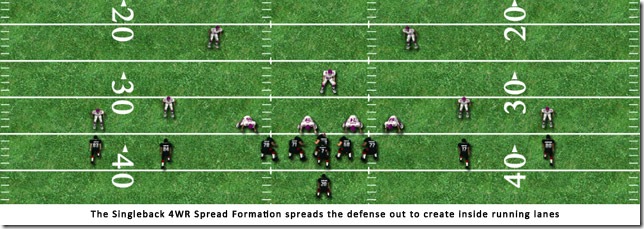
However, more and more teams like run out of Singleback Spread (see image above) sets to spread the defense out. The idea of this is to create more running lanes inside for the running back because the defense must spread itself to cover the receivers.
In this X’s and O’s Football breakdown, we show several Singleback formations, player Personal, formation Alignment, and formation style.
Singleback 4WR
The Singleback 4WR is a 2×2 alignment that has the left slot receiver and flanker lined up on the line of scrimmage. The split end and right slot receivers are lined up off the line of scrimmage.

Player Personnel:
Formation Alignment:
Formation Style:
Singleback Ace
The Singleback Ace has one tight end lined up on the right of the right tackle and one lined up on the left of the left tackle. Despite having two tight ends, this is a balanced formation that can be found in several playbooks.
The flanker and split end line up wide opposite each other. You will find a lot of the same plays throughout each playbook that has the Singleback Ace.

Singleback Ace Pair
The Singleback Ace Pair lines the two tight ends up on the same side of the field. This creates a play-side overload that favors the offense. Backside runs are also an option if the defense focuses too much on the two tight end side. The split end and flanker line up opposite each other out wide.

Singleback Ace Pair Slot
Two tight ends line up on the same side, while the two receivers line up on the opposite side. This is a good balanced formation. If your opponent likes to call man coverage, you may be able to call outside run plays towards the side of the tight ends to pick up yardage on the ground.

Singleback Ace Pair Twins

Singleback Ace Twins
The Singleback Ace Twins looks like the Singleback Ace as far as how the tight ends line up. The two receivers line up on the same side. The flanker lines up in the slot, while the split end lines up outside of him.

Singleback Big
The Singleback Big has one tight end lined up on the right of the right tackle and one lined up on the left of the left tackle. Despite having two tight ends, this is a balanced formation that can be found in several playbooks. The flanker and split end line up wide opposite each other.

Singleback Big 3TE
The Singleback Big 3TE features three tight ends in the lineup at the same time. The TE1 and TE3 line up on the right next to the right tackle. The TE2 lines up next to the LT. The flanker lines up out wide to the left. This formation, as you might expect, is a power run formation. The TE2 can be motioned to the same side as the TE1 and TE3. This puts three tight ends on the same side of the field.

Singleback Big Twin WR
The Singleback Big Twin WR looks like the Singleback Ace as far as how the tight ends line up. The two receivers line up on the same side. The flanker lines up in the slot, while the split end lines up outside of him.

Singleback Bunch
This is one of the better formations out of the Singleback set. There are a lot of bump-n-run man beaters to be found. The tight end, slot, and flanker are all clustered on the right. The split end lines up out wide on the left.

Singleback Bunch Swap
This set is similar to the Singleback Bunch, but with one difference. Instead of the tight end lining up next to the right tackle, he lines up in the slot in a three-point stance. The slot moves to the inside, where he lines up next to right tackle in a two-point stance.

Singleback Bunch TE
Found in only two playbooks, the Singleback Bunch TE has the tight end lined up on the left, while three receivers are bunched up on the right. If you motion the tight end out wide against bump-n-run man coverage and then motion him back inside, you will find you can get him off the line of scrimmage without being jammed.

Singleback Deuce
The Singleback Deuce is the Colts’ version of the Singleback Ace. Two tight ends line up on the line of scrimmage, while the split end and flanker line up off the line of scrimmage. A good portion of the pass plays are especially drawn up for the Colts offense.

Singleback Deuce Slot
The Singleback Deuce Slot replaces the third wide receiver with the TE1 in the slot. The TE1 and TE2 line up on the line of scrimmage, while the split end and flanker line up off the line of scrimmage. As with the Singleback Deuce, there are specific plays that were designed for the Colts in mind to get the TE1 in the slot open.

Singleback Deuce Wing
The Singleback Deuce Wing has both tight ends line up in wing positions. When we say wing, we mean off the line of scrimmage. The flanker and split end line up on the line of scrimmage.

Singleback Dice
The Singleback Dice is the Colts’ version of the Singleback Doubles. The slot and tight end line up on the line of scrimmage, while the flanker and split end line up off the line of scrimmage.

Singleback Dice Open
The Singleback Dice Open is the Colts’ version of the Singleback Spread. The left slot and flanker line up on the line of scrimmage, while the right slot and split end line up off the line of scrimmage.

Singleback Dice Slot
The Singleback Dice Slot lines the slot and flanker up off the line of scrimmage, while the split end and tight end line up on the line of scrimmage.

Singleback Dolphin Trips
Designed specifically to fit the Dolphins personnel, the Singleback Dolphin Trips has the tight end, slot receiver, and flanker all lined up on the same side, while the split end lines up on the opposite side wide.

Singleback Double Flex
This spread formation has the tight end flexed out in the right slot. The left slot also lines up on the line of scrimmage. The split end and flanker line up off the line of scrimmage.

Singleback Doubles
The Singleback Doubles is widely found throughout the offensive playbooks in Madden NFL 11 .. There aren’t any playbooks that really stand out since each one has a good mixture of plays. The split end and tight end line up on the line of scrimmage, while the slot and flanker line up off the line of scrimmage.

Singleback Doubles Close
This is the Colts’ version of the Singleback Tight. The two outside receivers line up off the line of scrimmage, while the two inside receivers line up on the line of scrimmage.

Singleback Doubles Pats
The Singleback Double Pats was designed specifically for the Patriots’ personnel. It moves the team’s number two receiver (Welker) into the slot. A few specific plays are designed for him to get open. The formation itself looks like the Singleback Doubles.

Singleback Eagle Slot
Designed specifically for the Eagles’ personnel, the Singleback Eagle Slot looks like the Singleback Doubles. The WR2 lines up in the slot. There are several plays in this formation that you won’t find in other playbooks.

Singleback F Pair Twins
This formation has the fullback replacing the second tight end. The fullback lines up outside of the tight end on the right. The flanker lines up in the slot on the left, while the split end lines up out wide on the left.

Singleback F Wing
The Singleback F Wing has the same personnel as the Singleback F Pair Twins. The fullback replaces the number two tight end and lines up at the wing position on the left. The flanker lines up out wide on the same side as the tight end. The split end lines up outside on the left.

Singleback Flex
The Singleback Flex has the slot and tight end lined up on the line of scrimmage, while the flanker and split end line up off the line of scrimmage. A few common Singleback Flex plays that most teams have are the Curls Flats, Flanker Drive, HB Dive, Inside Cross, PA Deep In, Slants, TE Post, and Y Shallow Cross.

Singleback Jumbo
The Singleback Jumbo features three tight ends in the lineup at the same time. The TE1 and TE3 line up on the right next to the right tackle. The TE2 lines up next to the LT. The flanker lines up out wide to the left. This formation, as you might expect, is a power run formation. The TE2 can be motioned to the same side as the TE1 and TE3. This puts three tight ends on the same side of the field.

Singleback Jumbo Z
The Singleback Jumbo Z features three tight ends in the lineup at the same time. The TE1 and TE3 line up on the right next to the right tackle. The TE2 lines up next to the LT. The flanker lines up out wide to the right. This formation, as you might expect, is a power run formation. The TE2 can be motioned to the same side as the TE1 and TE3. This puts three tight ends on the same side of the field. Found in the Broncos, Texans, and Vikings playbooks.

Singleback Normal Slot
In the Singleback Normal Slot, the split end and tight end line up on the line of scrimmage, while the slot and flanker line up off the line of scrimmage.

Singleback Pitt Doubles
The Singleback Pitt Doubles is specifically drawn up to fit the Steelers’ offensive personnel. The WR1 lines up in the slot off the line of scrimmage. A few plays are specifically designed for him to get open, such as Slot Cross, Slot Shake, and Slot Hook.
Singleback Slot Strong
In the Singleback Slot Strong, the tight end lines up on the line of scrimmage, while the slot and flanker line up off the line of scrimmage and on the same side. The split end lines up on the line of scrimmage.

Singleback Snugs
The Singleback Snugs can be found in one playbook and that’s in the Seahawks’. All the receivers line up tight in a 2×2 compressed alignment. The split end and flanker line up off the line of scrimmage, while the inside receiver lines up on the line of scrimmage.

Singleback Snugs Flip
The Singleback Snugs Flip is the same as the Singleback Snugs with four receivers lined up compressed in a 2×2 alignment. The difference between the two is that the outside receivers line up on the line of scrimmage, while the inside receivers line up off the line of scrimmage.

Singleback Spread
The Singleback Spread is a 2×2 alignment that has the split end and flanker lined up on the line of scrimmage. The left and right slot receivers are lined up off the line of scrimmage. There are many variations of this formation in the game. The key difference is how the receivers line up on the line of scrimmage.

Singleback Spread Flex
The Singleback Spread Flex has the split end and right slot receiver lined up off the line of scrimmage, while the left slot and flanker line up on the line of scrimmage.

Singleback Tight Doubles
The Singleback Tight Doubles has the split end and slot receiver lined up tight on the left. The slot lines up off the line of scrimmage, while the split end lines up on the line of scrimmage. The tight end and flanker line up on the right.

Compressed/Balanced
Singleback Tight Flex
This is another version of the Singleback Tight. The difference is in how the receivers line up and some of the plays within the formation itself. The Singleback Tight Flex has the left slot and flanker lined up off the line of scrimmage, while the split end and right slot receiver line up on the line of scrimmage.

Singleback Tight Slots
Found in the Lions’ and Panthers’ playbook, the Singleback Tight Slots has the outside receivers lined up on the line of scrimmage, while the inside receivers line up off the line of scrimmage. Both playbooks have a few unique plays. If we had to choose between the two, the Panthers’ playbook is the better choice to run the Singleback Tight Slots from.

Singleback Trey Open
The Singleback Trey Open has the tight end lined up farther outside of the right tackle. The slot and flanker are lined up on the right outside of the tight end, while the split end is lined up wide on the left.

Singleback Trips
Found in the Colts’ playbook, the Singleback Trips has the slot and flanker lined up off the line of scrimmage. The tight end lines up on the same side as the flanker and slot, but on the line of scrimmage. The split end lines up out wide on the left on the line of scrimmage.

Singleback Trips Bunch

Singleback Trips Colt
Specifically designed to fit the Colts’ players, the Singleback Trips Colts has a few unique plays that are not found in other Singleback Trips formations.

Singleback Trips Open
The Singleback Trips Open is found in two playbooks: Balanced and Broncos. Both have the same plays. The two slot receivers line up on the right and off the line of scrimmage. The flanker lines up on the same side, but he lines up outside and on the line of scrimmage. The split end lines up out wide left on the line of scrimmage.

Singleback Twin TE
The Singleback Twin TE lines the two tight ends up on the same side of the field. This creates a play-side overload that favors the offense. Backside runs are also an option if the defense focuses too much on the two tight end side. The split end and flanker line up opposite each other out wide.

Singleback Twin TE Slot
The Singleback Twin TE Slot has the TE1 and TE2 lined up on the right side next to the right tackle. The TE1 lines up on the line of scrimmage, while the TE2 lines up off the line of scrimmage. The flanker and split end line up on the left side. The flanker lines up in the slot, while the split end lines up out wide.

Singleback Wing Trio
The Singleback Wing Trio has the tight end lined up off the line of scrimmage in a wing position. The slot and flanker line up on the same side as the tight end. The flanker lines up off the line of scrimmage, while the slot lines up on the line of scrimmage. The split end lines up out left on the line of scrimmage.

Singleback Wing Trips
Singleback Wing Trips is the same as the Singleback Wing Trio, but there is one difference. The slot receiver is lined up off the line of scrimmage, along with the tight end. The flanker and split end are both lined up on the line of scrimmage.

Singleback Y-Trips
The Singleback Y-Trips has tight end lining up on the line of scrimmage, while the slot and flanker line up off the line of scrimmage and on the same side. The split end lines up off the line of scrimmage.

RELATED ARTICLES MORE FROM AUTHOR
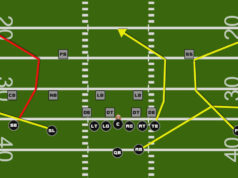
Post Corner High-Low Isolation Vs Cover 2 Zone Coverage
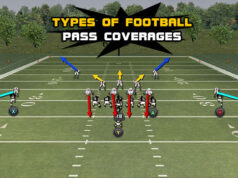
Types of Football Pass Coverages
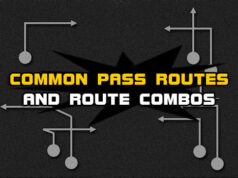
Common Pass Routes and Route Combos
Leave a reply cancel reply.
Save my name, email, and website in this browser for the next time I comment.
MORE MADDEN TIPS
Gun trips te – hb angle, backwards c route, 3-4 bear – pinch 0, the importance of madden sliders.

EVEN MORE NEWS

Gun Bunch Wk – Flood

Gun Doubles HB Strong – Y Cross

Gun Trips Left Hb Strong – S Motion Z Post
Popular category.
- Madden Tips 224
- Football Strategies 100
- Football Plays 77
- Kobra's Corner 26
- Digital Guides 10
Four-star 2025 safety commits to Ohio State football as secondary recruiting run continues
- Updated: Jun. 09, 2024, 1:59 p.m. |
- Published: Jun. 09, 2024, 1:52 p.m.
- Andrew Gillis, cleveland.com
COLUMBUS, Ohio — Ohio State’s 2025 class got even better on Sunday, as four-star Faheem Delane committed to the Buckeyes on the heels of his official visit weekend.
Delane, the No. 34 overall player and No. 2 safety in the class, had long been considered an Ohio State lean. Now, he’s officially part of the class.
Latest Ohio State Buckeyes news
- How do Ohio State’s veteran QBs impact future recruiting? Hey, Andrew!
- Previewing Ohio State football’s official visitors for second weekend of recruiting visits
- A 5-star target and previewing Ohio State football’s 2025 recruiting visitors: Buckeye Talk podcast
- Ohio State offers a handful of prospects at Thursday’s camp: Buckeye Breakfast
If you or a loved one has questions and needs to talk to a professional about gambling, call the Ohio Problem Gambling Helpline at 1-800-589-9966 or the National Council on Program Gambling Helpline (NCPG) at 1-800-522-4700 or visit 1800gambler.net for more information. 21+ and present in Ohio. Gambling problem? Call 1-800-Gambler.
If you purchase a product or register for an account through a link on our site, we may receive compensation. By using this site, you consent to our User Agreement and agree that your clicks, interactions, and personal information may be collected, recorded, and/or stored by us and social media and other third-party partners in accordance with our Privacy Policy.
- Live on Sky
- Get Sky Sports
- Sky Mobile Apps
- Kick It Out
- Black Lives Matter
- British South Asians in Football
Latest football news and gossip: France held to draw by Jesse Marsch's Canada as Italy beat Bosnia
Sorry, this blog is currently unavailable. Please try again later.

Stream the Canadian GP, T20 World Cup, US Open and more

- Upgrade Now
Why the giant, inflatable IUD that set DC abuzz could visit your town this year

A giant, inflatable IUD is going to travel across the country to help educate people about birth control this coming election season, after it made its first appearance in Washington, D.C., before the Senate voted against the Right to Contraception Act.
Americans for Contraception inserted the IUD, a form of birth control, last week to "educate, inform and empower the American public on what is under threat," Chris Fleming, a spokesperson for the group, told USA TODAY.
The 20-foot inflatable made its first appearance in front of D.C.'s Union Station. It garnered a lot of attention online when people began to post photos of it and jokes on social media.
Explainer: What is the 'Right to Contraception Act'? A look at how the bill failed and what was in it
"I hope Union Station took an ibuprofen before getting its giant IUD," posted one account to X, formerly known as Twitter.
"What if we kissed under the giant inflatable IUD?" posted another.
Why an IUD?
"It was an attention-grabbing way to educate the public, and it worked," said Fleming. He adds that the reaction has been overwhelmingly positive.
AFC inserted the IUD on Wednesday, the day the Right to Contraception Act was brought before the Senate.
"It's going to be making appearances across the country in important areas and states for a member election," said Fleming. "It's also gonna be in places where folks might not expect to see it, like in the South."
Jenny Marten, the health training manager at Planned Parenthood of Metropolitan Washington, DC, said she saw the IUD.
"I think it is a great opportunity for us to bring attention to a very important topic," Marten told USA TODAY.
Fleming did not reveal where exactly the IUD would pop up but said that it would continue to travel throughout the election year.
What is an IUD?
An IUD, or Intrauterine Device, is a form of reversible birth control. It's a plastic device that's shaped like the letter T and the size of a quarter, according to Marten. Doctors can place it in a person's uterus, and it can temporarily prevent future pregnancies.
"It's one of the most effective forms of birth control available," said Marten.
It's also growing in popularity.
Between 2006 and 2010, only 8% of women relied on an IUD for birth control, but, between 2015 and 2019, the number jumped to 20%, stated Marten.
While it works well to prevent pregnancies, people with IUDs can get them removed whenever they want to. Those who decide to have a baby can get it removed and immediately start trying to conceive.
"Every patient is different, but typically a person can get pregnant once the IUD has been removed," said Marten
Different types of IUDs
There are five different brands of IUDs, according to Planned Parenthood's website :
- Paragard - Copper, works for up to 12 years
- Mirena - Hormonal, works for up to eight years
- Liletta - Hormonal, works for up to eight years
- Kyleena - Hormonal, works for up to five years
- Skyla - Hormonal, works for up to three years
Some IUDs, which are fully plastic, prevent pregnancy by administering a hormone called progestin. Other IUDs, like Paragard, are nonhormonal and are wrapped in copper. Both work by changing the way sperm cells move in the uterus and prevent them from reaching an egg.
Emergency contraception
IUDs can also be used as a form of emergency contraception.
Similar to Plan B, they can be used to prevent pregnancy for up to 5 days after having unprotected sex, according to Marten.
However, despite common misconceptions, IUDs do not induce an abortion.
"Research has shown that IUDs are very effective and they're safe," she said. "Research has also shown that IUDs do not induce an abortion."
Right to Contraception Act
The Right to Contraception Act set out to protect a person's right to access birth control, and a medical provider's right to prescribe it.
However, Senate Republicans blocked the bill.
Sen. Marco Rubio and other Republican senators who voted against the bill, signed a letter that explained why they opposed the bill.
"There is no threat to access to contraception," states the letter. It adds that the bill infringes on parental rights.
The senators who signed the letter called it a "stunt legislation."
"Why do you need a law to address a problem that doesn't exist?" asked Rubio at a press conference that was posted on X.
However, Democrats disagree. President Joe Biden said GOP lawmakers have already attacked access to contraception by proposing to defund the Title X Family Planning Program , the only program that is only dedicated to family planning.
"Dangerous and extreme abortion bans are putting women's health and lives at risk, and disrupting access to critical health care services, including contraception, as health care providers are forced to close in states across the country," said Biden. "Attacks on contraception are an affront to women's dignity and their ability to make their own decisions about their lives."
Though the bill was rejected,. Senate Majority Leader Chuck Schumer, D-N.Y., changed his vote to "nay," which will allow him to bring the legislation to the floor again in the future.
Contributing: Rachel Barber , USA TODAY

IMAGES
VIDEO
COMMENTS
The Master Of Disguise One of the more popular spread-formation looks our opponents use is the Trips or 3-by-1 set. By having three receivers on one side — a wide receiver (WR) and two slot receivers, or, a WR off the line of scrimmage (LOS) with a slot receiver and a tight end — and a WR on the weak side, the offense creates an unbalanced-spread look, which challenges the defense to match up.
Smash + Drive is a trips passing concept that is a personal favorite because it has answers for multiple coverages. Typically, the trips are to the field and to the boundary will be a single WR in a nasty split, or an attached TE. The smash concept will be ran to the single WR side. The single receiver will run the corner and the running back ...
Shotgun, trips right. A trips formation is an offensive football formation, initially used by Joe Gibbs and the Washington Redskins, in which three receivers line up on the same side of the field.The side is usually specified by the quarterback calling "Trips right" or "Trips left" when he calls the play in the huddle.. There are multiple variables of the trips formation, and it may be ...
Chapter 1: Why Use The Trips Formation? Coaches at every level are always looking for an edge competitively over their opponents. The use of the trips formation has become a very popular way to gain an advantage by placing additional receivers to one side of the formation thus making the offensive formation unbalanced with receivers by having ...
Play #1: Smash. Smash is a play in which the two inside receivers will attack the deep part of the field, while the two outside receivers will run short routes. This is a great play as it attacks the defense on multiple levels, and creates different looks on each side of the field. Against zone, Smash usually sees the outside receivers having ...
Basics of Coverage in the 4-2-5 Defense. The 4-2-5 Defense is an 8-Man Front defense, with no 2-gap players. Cover 3 is the base coverage, a single-high safety coverage that is great against the run and adequate for stopping the pass. The two overhang safeties or Outside Linebackers, which we call the Weak Safety and Strong Safety, are almost ...
Trips sets are football's simplest unbalanced concepts and require some sort of compensation from the defense to match the numbers advantage created by the offense to the trips side. While there are many types of 3x1 sets and therefore many different ways to play them, I am going to highlight today our base "Midpoints" check that we use ...
Let's delve into some of the best plays commonly employed when utilizing the Trips formation. 1. Smash. The Smash play is a versatile concept that provides answers against multiple coverages. In this play, the Trips side features a single wide receiver running a corner route, while the running back executes an arrow route into the flat.
Use a Cover 6 Defense to Stop 3 by 1. Cover 6 Defense is more widely known as Quarter-Quarter-Half Coverage. It is primarily used as an adjustment to trips formations and it's going to be the subject of our deep dive in this episode of The Football Coaching Podcast. The Cover 6 Defense is a combination coverage between Cover 4 and Cover 2.
In Part 1 of this Cover 7 series, we went over basic coverages in the Cover 7 family against two-by-two sets and one trips (three receivers on one side) adjustment (Clip).In Part 2, we will go ...
Spack will play most trips teams in a base 4-3 cover 2 scheme, but will always make sure he has enough support to stop the run on the weak side. According to Spack, when the offense comes out in a trips set, defending it lies in figuring out whether they want to spread you out and run or spread you out and pass.
Analysis 1: Understanding the Basic Structure of the Jim Leavitt 3-4 Defense. Analysis 2: The Jim Leavitt 3-4: Oregon's Defensive Fronts. Analysis 3: The Jim Leavitt 3-4: Triangle Coverage with ...
For example, one of the greatest college football teams of all time, the 1995 Nebraska Cornhuskers, won a national championship the I Formation as their primary formation. Their head coach Tom Osborne ran a triple option offense and everyone, including the fullback, was a threat to carry the football.
Maximizing the 3 x 1 Formation. Coach Bill Russell. by Doug Heslip. The trips formation has multiple combinations of plays that can give a defensive coordinator coverage nightmares. The 3 x 1 formation is an offensive set that puts your best athletes in a position to use their explosive movements in space. The quick slant on the single receiver ...
Defending the Trips Formation | Special Coverage. As offenses move to more wide open formations it's important that defenses have the ability to respond to these formations. One of the most popular formations in football is the Trips formation. The Trips formation has three receivers to the wide side of the field and one receiver on the backside.
Passing Game Formations Part 2. by. This post is a follow up to Passing Game Formations Part 1. Installing Formations and Backfield Sets. Trips Right / Left. Gun Trips Right / Left. Pistol Trips Right / Left. The difference between Trips and Orange is the alignment of the Tight End. In Orange you get three receivers to the Tight End.
Most NFL offenses operate out of Trips-Bunch formations. Here we use NFL All-22 film to break down various ways defenses attack those formations, overviewing Cover 1, 2 and 3 along with various checks and wrinkles. ... the best thing a casual fan can do if they want to learn more about football is study as much as possible. With the access to ...
There are various ways to call in the play: •. COLOR ## (Either number can be the live number, we usually set it as the second number, the other number is random) Example: "WHITE 36". Go to the WHITE pod of the wristband (1st pod), find play "6", 6 is an even number, so the resulting play is DASH RIGHT.
Shotgun Y-Trips Open . The Shotgun Y-Trips Open has the tight end slot receiver lined up off the line of scrimmage to the right side of the field. The flanker is also lined up on the right, but on the line of scrimmage. The split end lines up on the line of scrimmage on the left side. Player Personnel: 1 HB. 3 WR. 1 TE. Formation Alignment: 3× ...
Football is littered with specialized terminology. From punt gunner to 0 technique, commentators and writers rarely get to explain everything you need to know before the next play. Inside The Pylon's glossary t akes you inside part of the game you may be missing. Trips Formation. Trips, usually followed by the designation "left" or "right" is short for "triple," and refers to ...
University of Tennessee head coach Jeremy Pruitt details how the Vols defend 3x1 formations from split-safety looks. The coverage that Pruitt details is known as Quarters, or Cover 7 in Pruitt's world. The first coverage Pruitt is going to explain is known as "Stump.". Stump. On the weakside of the formation - the one receiver side ...
Singleback Trips Bunch . This is one of the better formations out of the Singleback set. There are a lot of bump-n-run man beaters to be found. The tight end, slot, and flanker are all clustered on the right. The split end lines up out wide on the left. Player Personnel: 1 HB. 3 WR. 1 TE. Formation Alignment: 3×1. Formation Style: Compressed ...
The X Y Z receivers are offensive positions in American football. The Z receiver is a wide receiver that lines up off the line of scrimmage. The X receiver, also known as the split end, lines up on the line of scrimmage. Last, the Y receiver is the tight end that lines up on the line of scrimmage. These receivers typically play into all types ...
Matthew Outten was back at Penn State for an official visit. He has two more trips set and he broke down his latest trip to Happy Valley. Top247 receiver Matthew Outten has two more official ...
Visit the official source for NFL News, NFL schedules, stats, scores and more. Get all the latest NFL Football news now!
By Travis Parker. Whether you call it "soccer" or "football," Europe's favorite sport will be in the global spotlight this summer as Germany hosts Euro 2024. Officially called the UEFA Men's European Football Championship — but also known as the Euro Cup, or simply the Euros — this tournament is, to many Europeans, an even bigger deal than ...
COLUMBUS, Ohio — Ohio State's 2025 class got even better on Sunday, as four-star Faheem Delane committed to the Buckeyes on the heels of his official visit weekend. Delane, the No. 34 overall ...
On3 has Salmin currently ranked highest, sitting as the No. 139 overall player and No. 21 pass catcher in the 2026 recruiting class. ESPN also has him ranked as a top 200 overall player, coming in ...
This content is provided by , which may be using cookies and other technologies.To show you this content, we need your permission to use cookies. You can use the buttons below to amend your ...
A giant, inflatable IUD is going to travel across the country to help educate people about birth control this coming election season, after it made its first appearance in Washington, D.C., before ...